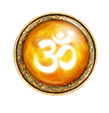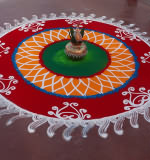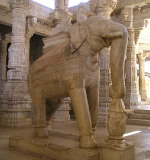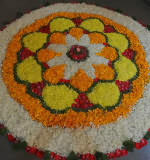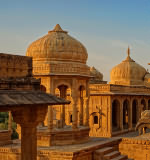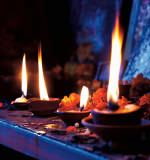| Download and install the indispensable font(s) to view Sanskrit in its full glory Read Transliterating (2) (English) to fully understand the transliteration system |
Tantrāloka (Tantraloka): Chapter 16 - stanzas 1 to 156 - Non-dual Shaivism of Kashmir
Pautrikavidhiḥ
Introduction
 This is the first set of stanzas (from the stanza 1 to the stanza 156) of the sixteenth chapter (called Pautrikavidhiḥ).
This is the first set of stanzas (from the stanza 1 to the stanza 156) of the sixteenth chapter (called Pautrikavidhiḥ).
This work was written by the great Master Abhinavagupta and is a compendium of Tantra in all its facets. Tantrāloka is the most important and voluminous work of the greatest Trika Master. Abhinavagupta was also the teacher of eminent Kṣemarāja and lived about 975-1025 AD in Kashmir.
This treatise whose name is Tantrāloka is a complete encyclopedia of Tantra. Since it is a very advanced text in Trika Shaivism, there is no surprise if a neophyte finds it difficult to understand. To start to understand it, the level of the reader must be the one of a real disciple in Trika Shaivism. If this requirement is not met, then there will be a lot of confusion and constant disappointment. Because in spite of my great efforts to explain the things so easily as possible, to study this treatise requires some spiritual caliber. In this system, sometimes it is not possible even to write about certain topics due to the extreme limitation of the words. Because in the end, all this knowledge has to do with 'states', and it is extremely difficult to write about 'states' in a precise way. Abhinavagupta has done his best to accomplish this formidable task of writing about what is superior and intangible. Anyway, despite his incredible skills to carry out this, he is not revealing everything. It is not because he is all the time hiding things from the reader, but because he is sometimes hiding and on other occasions he just cannot write about some extremely subtle topics because of the limitation of the words.
Goal of life is Liberation. Man has searched for freedom always in human history, but according to Trika Shaivism that is not real Liberation. Real Liberation does not mean that your body should be free from some prison and things like that. Real Liberation amounts to attaining His Svātantrya or Absolute Freedom. When the Great Lord's Svātantrya is achieved, then you see unity in all the things, i.e. you stop seeing duality as before. All is forever identified with Svātantrya, with Him, and that is the end of the story called 'you in bondage'. From this point on nothing will get in your way, because if something apparently gets in your way, that is Svātantrya again. This constant awareness of unity in all is real Freedom. There is no other attainment greater than this!
Keeping the above in mind, now read Tantrāloka and experience Supreme Delight, dear Śiva.
Important: All that is in brackets and italicized within the translation has been added by me in order to complete the sense of a particular phrase or sentence. In turn, all that is between double hyphen (--...--) constitutes clarifying further information also added by me.
Stanzas 1 to 30
अथ श्रीतन्त्रालोके षोडशमाह्निकम्।
Atha śrītantrāloke ṣoḍaśamāhnikam|
Here begins (atha) the sixteenth (ṣoḍaśam) chapter (āhnikam) in venerable Tantrāloka (śrī-tantrāloke)|
अथ पुत्रकत्वसिद्ध्यै निरूप्यते शिवनिरूपितोऽत्र विधिः।
Atha putrakatvasiddhyai nirūpyate śivanirūpito'tra vidhiḥ|
And now (atha), for the accomplishment of the condition of spiritual son (putrakatva-siddhyai), the method (vidhiḥ) that has been described by Śiva (śiva-nirūpitaḥ) is here investigated (nirūpyate... atra)|
यदा तु समयस्थस्य पुत्रकत्वे नियोजनम्।
गुरुत्वे साधकत्वे वा कर्तुमिच्छति दैशिकः॥१॥
तदाधिवासं कृत्वाह्नि द्वितीये मण्डलं लिखेत्।
सामुदायिकयागेऽथ तथान्यत्र यथोदितम्॥२॥
षडष्टतद्द्विगुणितचतुर्विंशतिसङ्ख्यया।
चक्रपञ्चकमाख्यातं शास्त्रे श्रीपूर्वसञ्ज्ञिते॥३॥
द्वात्रिंशत्तद्द्विगुणितं श्रीमत्त्रैशिरसे मते।
असङ्ख्यचक्रसम्बन्धः श्रीसिद्धादौ निरूपितः॥४॥
तस्माद्यथा तथा यागं यावच्चक्रेण सम्मतम्।
पूजयेद्येन तेनात्र त्रिशूलत्रयमालिखेत्॥५॥
त्रिशूलत्रितये देवीत्रयं पर्यायवृत्तितः।
मध्यसव्यान्यभेदेन पूर्णं सम्पूजितं भवेत्॥६॥
वर्तना मण्डलस्याग्रे सङ्क्षेपादुपदेक्ष्यते।
आलिख्य मण्डलं गन्धवस्त्रेणैवास्य मार्जनम्॥७॥
कृत्वा स्नातो गुरुः प्राग्वन्मण्डलाग्रेऽत्र देवताः।
बाह्यगाः पूजयेद्द्वारदेशे च द्वारदेवताः॥८॥
मण्डलस्य पुरोभागे तदैशानदिशः क्रमात्।
आग्नेय्यन्तं गणेशादीन्क्षेत्रपान्तान्प्रपूजयेत्॥९॥
गणपतिगुरुपरमाख्याः परमेष्ठी पूर्वसिद्धवाक्क्षेत्रपतिः।
इति सप्तकमाख्यातं गुरुपङ्क्तिविधौ प्रपूज्यमस्मद्गुरुभिः॥१०॥
तत आज्ञां गृहीत्वा तु पुष्पधूपादिपूजितम्।
पूज्यमाधारशक्त्यादि शूलमूलात्प्रभृत्यलम्॥११॥
शिवान्तं सितपद्मान्ते त्रिशूलानां त्रये क्रमात्।
मध्यशूले मध्यगः स्यात्सद्भावः परया सह॥१२॥
वामे चापरया साकं नवात्मा दक्षगं परम्।
त्रिशूले दक्षिणे मध्यशृङ्गस्थो रतिशेखरः॥१३॥
स्यात्परापरया साकं दक्षे भैरवसत्परे।
वामे त्रिशूले मध्यस्थो नवात्मापरया सह॥१४॥
स्यात्परे परया साकं वामारे संश्च भैरवः।
इत्थं सर्वगतत्वे श्रीपरादेव्याः स्थिते सति॥१५॥
यागो भवेत्सुसम्पूर्णस्तदधिष्ठानमात्रतः।
एकशूलेऽप्यतो यागे चिन्तयेत्तदधिष्ठितम्॥१६॥
अविधिज्ञो विधानज्ञ इत्येवं त्रीशिकोदितम्।
ततो मध्ये तथा दक्षे वामे शृङ्गे च सर्वतः॥१७॥
लोकपालास्त्रपर्यन्तमेकात्मत्वेन पूजयेत्।
परत्वेन च सर्वासां देवतानां प्रपूजयेत्॥१८॥
श्रीमन्तं मातृसद्भावभट्टारकमनामयम्।
ततोऽपि भोगयागेन विद्याङ्गं भैरवाष्टकम्॥१९॥
यामलं चक्रदेवीश्च स्वस्थाने पूजयेद्बहिः।
लोकपालानस्त्रयुतान्गन्धपुष्पासवादिभिः॥२०॥
पूजयेत्परया भक्त्या वित्तशाठ्यविवर्जितः।
ततः कुम्भास्त्रकलशीमण्डलस्थानलात्मनाम्॥२१॥
पञ्चानामनुसन्धानं कुर्यादद्वयभावनात्।
ये तु तामद्वयव्याप्तिं न विन्दन्ति शिवात्मिकाम्॥२२॥
मन्त्रनाडीप्रयोगेण ते विशन्त्यद्वये पथि।
स्वदक्षिणेन निःसृत्य मण्डलस्थस्य वामतः॥२३॥
प्रविश्यान्येन निःसृत्य कुम्भस्थे कर्करीगते।
वह्निस्थे च क्रमेणेत्थं यावत्स्वस्मिन्स्ववामतः॥२४॥
मूलानुसन्धानबलात्प्राणतन्तूम्भने सति।
इत्थमैक्यस्फुरत्तात्मा व्याप्तिसंवित्प्रकाशते॥२५॥
ततो विशेषपूजां च कुर्यादद्वयभाविताम्।
यच्छिवाद्वयपीयूषसंसिक्तं परमं हि तत्॥२६॥
तेनार्घपुष्पगन्धादेरासवस्य पशोरथ।
या शिवाद्वयतादृष्टिः सा शुद्धिः परमीकृतिः॥२७॥
निवेदयेद्विभोरग्रे जीवान्धातूंस्तदुत्थितान्।
सिद्धानसिद्धान्व्यामिश्रान्यद्वा किञ्चिच्चराचरम्॥२८॥
दृष्टप्रोक्षितसन्द्रष्टृप्रालब्धोपात्तयोजिताः।
निर्वापितो वीरपशुः सोऽष्टधोत्तरतोत्तमाः॥२९॥
यथोत्तरं न दातव्यमयोग्येभ्यः कदाचन।
शिवोपयुक्तं हि हविर्न सर्वो भोक्तुमर्हति॥३०॥
Yadā tu samayasthasya putrakatve niyojanam|
Gurutve sādhakatve vā kartumicchati daiśikaḥ||1||
Tadādhivāsaṁ kṛtvāhni dvitīye maṇḍalaṁ likhet|
Sāmudāyikayāge'tha tathānyatra yathoditam||2||
Ṣaḍaṣṭataddviguṇitacaturviṁśatisaṅkhyayā|
Cakrapañcakamākhyātaṁ śāstre śrīpūrvasañjñite||3||
Dvātriṁśattaddviguṇitaṁ śrīmattraiśirase mate|
Asaṅkhyacakrasambandhaḥ śrīsiddhādau nirūpitaḥ||4||
Tasmādyathā tathā yāgaṁ yāvaccakreṇa sammatam|
Pūjayedyena tenātra triśūlatrayamālikhet||5||
Triśūlatritaye devītrayaṁ paryāyavṛttitaḥ|
Madhyasavyānyabhedena pūrṇaṁ sampūjitaṁ bhavet||6||
Vartanā maṇḍalasyāgre saṅkṣepādupadekṣyate|
Ālikhya maṇḍalaṁ gandhavastreṇaivāsya mārjanam||7||
Kṛtvā snāto guruḥ prāgvanmaṇḍalāgre'tra devatāḥ|
Bāhyagāḥ pūjayeddvāradeśe ca dvāradevatāḥ||8||
Maṇḍalasya purobhāge tadaiśānadiśaḥ kramāt|
Āgneyyantaṁ gaṇeśādīnkṣetrapāntānprapūjayet||9||
Gaṇapatiguruparamākhyāḥ parameṣṭhī pūrvasiddhavākkṣetrapatiḥ|
Iti saptakamākhyātaṁ gurupaṅktividhau prapūjyamasmadgurubhiḥ||10||
Tata ājñāṁ gṛhītvā tu puṣpadhūpādipūjitam|
Pūjyamādhāraśaktyādi śūlamūlātprabhṛtyalam||11||
Śivāntaṁ sitapadmānte triśūlānāṁ traye kramāt|
Madhyaśūle madhyagaḥ syātsadbhāvaḥ parayā saha||12||
Vāme cāparayā sākaṁ navātmā dakṣagaṁ param|
Triśūle dakṣiṇe madhyaśṛṅgastho ratiśekharaḥ||13||
Syātparāparayā sākaṁ dakṣe bhairavasatpare|
Vāme triśūle madhyastho navātmāparayā saha||14||
Syātpare parayā sākaṁ vāmāre saṁśca bhairavaḥ|
Itthaṁ sarvagatatve śrīparādevyāḥ sthite sati||15||
Yāgo bhavetsusampūrṇastadadhiṣṭhānamātrataḥ|
Ekaśūle'pyato yāge cintayettadadhiṣṭhitam||16||
Avidhijño vidhānajña ityevaṁ trīśikoditam|
Tato madhye tathā dakṣe vāme śṛṅge ca sarvataḥ||17||
Lokapālāstraparyantamekātmatvena pūjayet|
Paratvena ca sarvāsāṁ devatānāṁ prapūjayet||18||
Śrīmantaṁ mātṛsadbhāvabhaṭṭārakamanāmayam|
Tato'pi bhogayāgena vidyāṅgaṁ bhairavāṣṭakam||19||
Yāmalaṁ cakradevīśca svasthāne pūjayedbahiḥ|
Lokapālānastrayutāngandhapuṣpāsavādibhiḥ||20||
Pūjayetparayā bhaktyā vittaśāṭhyavivarjitaḥ|
Tataḥ kumbhāstrakalaśīmaṇḍalasthānalātmanām||21||
Pañcānāmanusandhānaṁ kuryādadvayabhāvanāt|
Ye tu tāmadvayavyāptiṁ na vindanti śivātmikām||22||
Mantranāḍīprayogeṇa te viśantyadvaye pathi|
Svadakṣiṇena niḥsṛtya maṇḍalasthasya vāmataḥ||23||
Praviśyānyena niḥsṛtya kumbhasthe karkarīgate|
Vahnisthe ca krameṇetthaṁ yāvatsvasminsvavāmataḥ||24||
Mūlānusandhānabalātprāṇatantūmbhane sati|
Itthamaikyasphurattātmā vyāptisaṁvitprakāśate||25||
Tato viśeṣapūjāṁ ca kuryādadvayabhāvitām|
Yacchivādvayapīyūṣasaṁsiktaṁ paramaṁ hi tat||26||
Tenārghapuṣpagandhāderāsavasya paśoratha|
Yā śivādvayatādṛṣṭiḥ sā śuddhiḥ paramīkṛtiḥ||27||
Nivedayedvibhoragre jīvāndhātūṁstadutthitān|
Siddhānasiddhānvyāmiśrānyadvā kiñciccarācaram||28||
Dṛṣṭaprokṣitasandraṣṭṛprālabdhopāttayojitāḥ|
Nirvāpito vīrapaśuḥ so'ṣṭadhottaratottamāḥ||29||
Yathottaraṁ na dātavyamayogyebhyaḥ kadācana|
Śivopayuktaṁ hi havirna sarvo bhoktumarhati||30||
When (yadā) a Guru (daiśikaḥ) wishes (icchati) to appoint (niyojanam... kartum) someone who has received dīkṣā sāmayī --i.e. who has received initiation into discipline or rules-- (samaya-sthasya) to the conditions of spiritual son (putrakatve), Guru (gurutve) or (vā) adept (sādhakatve), then (tadā) after performing (kṛtvā) the preliminary consecration (adhivāsam), he should draw (likhet) the maṇḍala (maṇḍalam) on the second day (ahni dvitīye) as it has been specified (yathā uditam) regarding the composite sacrifice (sāmudāyika-yāge) and also (atha tathā) elsewhere (anyatra).
A group of five cakra-s or wheels (cakra-pañcakam) is designated (ākhyātam) by the numbers six, eight, twelve, sixteen --"tad-dviguṇita" literally means "that doubled", i.e. "six and eight" doubled equals to "twelve and sixteen"-- and twenty-four --these are the numbers of spokes present in each of those cakra-s or wheels-- (ṣaṭ-aṣṭa-tad-dviguṇita-caturviṁśati-saṅkhyayā) in the scripture (śāstre) called "Śrīpūrva" --viz. Mālinīvijayottaratantra-- (śrī-pūrva-sañjñite). (On the other hand,) in venerable Traiśiramata (śrīmat-traiśirase mate), (Śiva has enumerated cakra-s or wheels with) thirty-two and sixty-four (spokes) (dvātriṁśat-tad-dviguṇitam), (while) in venerable Siddhā, etc. (śrī-siddhā-ādau), the connection between innumerable cakra-s or wheels (asaṅkhya-cakra-sambandhaḥ) is described (nirūpitaḥ).
Therefore (tasmāt), while (yāvat) he worships (pūjayet), in whatever way (yathā tathā), the celebrated (sammatam) sacrifice (yāgam) by which (yena) —i.e. by the cakra or wheel (cakreṇa)—, he should draw (ālikhet) here (atra) a group of three tridents (triśūla-trayam) together with it (tena) --far-fetched Sanskrit here--.
The triad of goddesses (devī-trayam), alternately (paryāyavṛttitaḥ), on the triad of tridents (triśūla-tritaye), by the division in the middle, on the right and on the left (madhya-savya-anya-bhedena), should be (bhavet) fully (pūrṇam) worshiped (sampūjitam). The procedure to draw (vartanā) the maṇḍala (maṇḍalasya) will be concisely explained (saṅkṣepāt upadekṣyate) further on (agre).
Having drawn (ālikhya) the maṇḍala (maṇḍalam), (and) having cleaned it (asya mārjanam kṛtvā) with a perfurmed cloth (gandha-vastreṇa eva), the Guru (guruḥ) —who has taken a bath (snātaḥ)— should worship (pūjayet), as before (prāk-vat), the external (bāhya-gāḥ) deities (devatāḥ) here (atra) —in front of the maṇḍala (maṇḍala-agre)—, and (ca) the deities of the door (dvāra-devatāḥ) in the place where the door is (dvāra-deśe). On the front portion (purobhāge) of the maṇḍala (maṇḍalasya), he should then worship (tadā... prapūjayet), in succession (kramāt) —from the northeastern direction (aiśāna-diśaḥ) up to the southeastern (direction) (āgneyī-antam)—, (the deities who) start with Gaṇeśa (gaṇeśa-ādīn) (and) end in the guardians/protectors of the place (kṣetra-pa-antān). According to my Guru --lit. according to my Guru-s-- (asmad-gurubhiḥ), in the procedure of the series of Guru-s (guru-paṅkti-vidhau), that which is called (ākhyāta) the group of seven (saptakam) is to be worshiped (prapūjyam): Those who names are (1) Gaṇapati, (2) the Guru, (3) the Guru of the Guru (gaṇapati-guru-parama-ākhyāḥ), (4) the Guru of the Guru of the Guru (parameṣṭhī), (5) the first Siddha or Perfected Master, (6) Speech --the Goddess-- and (7) the lord of the place (pūrva-siddha-vāk-kṣetra-patiḥ). After that (tatas), having gotten (gṛhītvā tu) the command (ājñām), the object of worship (pūjyam) —the śakti of the support, etc. (ādhāra-śakti-ādi)— is worshiped with flowers, incense, etc. (puṣpa-dhūpa-ādi-pūjitam), beginning (prabhṛti alam) from the root of the trident (śūla-mūlāt) up to Śiva (śiva-antam), at the end of the white lotus (sita-padma-ante). Regarding the triad (traye) of tridents (triśūlānām), (the procedure is to be repeated) in order/successively (kramāt).
Bhairavasadbhāva (sadbhāvaḥ) is (syāt) on the middle (prong) (madhya-gaḥ) of the middle trident (madhya-śūle), together with Parā (parayā saha). Navātmā (navātmā) (is) on the left (prong) (vāme ca) along with Aparā (aparayā sākam), (and) the other (couple) --i.e. Ratiśekhara and Parāparā-- (param) is on the right (prong) (dakṣa-gam). In the trident on the right side (triśūle dakṣiṇe), Ratiśekhara (ratiśekharaḥ) is on the middle prong (madhya-śṛṅga-sthaḥ... syāt) together with Parāparā (parāparayā sākam). Bhairavasadbhāva (bhairavasat) (is) on the right (prong along with Parā) (dakṣe). On the other (prong) --i.e. on the left prong-- (pare) (there is Navātmā with Aparā). In the trident on the left side (vāme triśūle), Navātmā (navātmā) is on the middle (prong) (madhya-sthaḥ... syāt) together with Aparā (aparayā saha). Bhairavasadbhāva (bhairavaḥ) is (san ca) on the other left prong (pare... vāma-are) along with Parā (parayā sākam). (While Ratiśekhara, with Parāparā, is on the right prong).
In this way (ittham), when there is omnipresence (sarvagatatve... sthite sati) of the venerable Goddess Parā (śrī-parā-devyāḥ), the sacrifice (yāgaḥ) becomes (bhavet) totally perfect/full (su-sampūrṇaḥ) due to only Her authority/Power --viz. because She presides over the sacrifice-- (tad-adhiṣṭhāna-mātratas). On this account (atas), even (api) in the sacrifice containing one trident (eka-śūle... yāge), he should think (cintayet) (that the sacrifice) is presided by Her (tad-adhiṣṭhitam). Thus (evam), it is said in Parātrīśikā (trīśikā-uditam): "He who does not know the procedure (a-vidhi-jñaḥ) (becomes) someone who knows the procedure (vidhāna-jñaḥ iti)". After that (tatas), he should completely worship (sarvatas... pūjayet) on the middle (madhye) prong (śṛṅge) as well as (tathā) on the right (one) (dakṣe) and (ca) on the left (one) (vāme), up to the protectors of the world with their weapons (loka-pāla-astra-paryantam), as if they were one (ekātmatvena). Also (ca), he should worship (prapūjayet) the venerable (śrīmantam) (and) pure --lit. free from disease-- (anāmayam) Mātṛsadbhāvabhaṭṭāraka --lit. the worshipful Mātṛsadbhāva-- (mātṛsadbhāva-bhaṭṭārakam) as the supreme (paratvena) (Divinity) of all the deities (sarvāsām devatānām). Afterward (tatas api), in a sacrifice to obtain worldly enjoyment (bhoga-yāgena), he should worship (pūjayet) the limb(s) of the Vidyā-s (vidyā-aṅgam), the group of eight Bhairava-s (bhairava-aṣṭakam), the pair (yāmala), and (ca) the Goddesses of the wheels (cakra-devīḥ), in their own place (sva-sthāne). He should worship (pūjayet) externally (bahis) —with supreme devotion (parayā bhaktyā), through fragrances, flowers, spirituous liquor, etc. (gandha-puṣpa-āsava-ādibhiḥ), (and) devoid of cheating in money matters --that means that he should not be stingy regarding this-- (vittaśāṭhya-vivarjitaḥ)— the protectors of the world (loka-pālān) endowed with weapons (astra-yutān). Then (tatas), he should produce (kuryāt) the congruous and suitable union (anusandhānam) of the five (pañcānām) —of (1) big pot, (2) weapon --i.e. Phaṭ--, (3) small pot, (4) fire in the maṇḍala, (and) (5) Self (kumbha-astra-kalaśī-maṇḍala-stha-anala-ātmanām)— through a non-dualistic contemplation (advaya-bhāvanāt). But (tu) those (te) who (ye) do not attain (na vindanti) that penetration into non-dualism which is Śiva (tām advaya-vyāptim... śiva-ātmikām), enter (viśanti) into the non-dualistic path (advaye pathi) by means of Mantra-s and subtle channels (mantra-nāḍī-prayogeṇa).
After exhaling --lit. after going out-- (niḥsṛtya) toward his own right (sva-dakṣiṇena), (and) inhaling --lit. after penetrating-- (praviśya) toward the left (vāmatas) of (the deity) remaining in the maṇḍala (maṇḍala-sthasya), (and) after exhaling (again) (niḥsṛtya) toward the other --i.e. to the right again-- (anyena)... (by continuing to do this) in order/successively (krameṇa) in this way (ittham) regarding (the deities) remaining in the big pot, the small pot and the fire (kumbha-sthe karkarī-gate... vahni-sthe ca), until (yāvat), through his own left (sva-vāmatas) in himself (svasmin), they become united with the thread of the vital energy --"umbhana" seems to come from the root "ubh" (to compact together), but it looks more like a typo-- (prāṇa-tantu-umbhane sati) by force of a close inspection of the root (Mantra) (mūla-anusandhāna-balāt). In this way (ittham), consciousness of pervasion (vyāpti-saṁvid) whose essence is a throb of unity (aikya-sphurattā-ātmā) shines (prakāśate). After that (tatas), he should perform (kuryāt) a special worship (viśeṣa-pūjām ca) which is soaked in non-dualism (advaya-bhāvitām).
That (tad) (is) indeed (hi) supreme (paramam) which (yad) is well sprinkled with the ambrosia of the unity with Śiva (śiva-advaya-pīyūṣa-saṁsiktam). For that reason (tena), the purification (sā śuddhiḥ) —which (yā) (is) the act of causing the liquid (in the vessel or arghapātra), the flowers, the fragrances, etc. (along with) the spirituous liquor and the animal to be supreme (argha-puṣpa-gandha-ādeḥ āsavasya paśoḥ atha... paramīkṛtiḥ)— (is) the viewpoint of unity with Śiva (śiva-advayatā-dṛṣṭiḥ).
In front (agre) of the Lord (vibhoḥ), he should offer (nivedayet) living (animals) (jīvān) (and) the constituents (dhātūn) arisen from them (tad-utthitān), (whether they are) cooked or not (siddhān asiddhān), (or even) mixed --cooked and uncooked-- (vyāmiśrān), or (vā) whatever (yad... kiñcid) (is) moving and stationary --referring to animals and plants-- (cara-acaram).
It --the sacrificial animal-- (saḥ) (is) eightfold --i.e. there are eight kinds of sacrificial animals-- (aṣṭadhā) —from least to greatest (uttarata-uttamāḥ)—: (1) Seen, (2) sprinkled, (3) beholding well, (4) seized, (5) acquired, (6) yoked/connected (dṛṣṭa-prokṣita-sandraṣṭṛ-prālabdha-upātta-yojitāḥ), (7) offered as an oblation (nirvāpitaḥ), (and) (8) heroic animal (vīra-paśuḥ). For instance (yathā), a high type (of animals) (uttaram) must never be given (na dātavyam... kadācana) to those who are unfit (ayogyebhyaḥ). Not (na) everyone (sarvaḥ) certainly (hi) deserves (arhati) to eat (bhoktum) the oblation (havid) that is suitable for Śiva (śiva-upayuktam)||1-30||
Stanzas 31 to 51
यस्तु दीक्षाविहीनोऽपि शिवेच्छाविधिचोदितः।
भक्त्याश्नाति स सम्पूर्णः समयी स्यात्सुभावितः॥३१॥
Yastu dīkṣāvihīno'pi śivecchāvidhicoditaḥ|
Bhaktyāśnāti sa sampūrṇaḥ samayī syātsubhāvitaḥ||31||
But (tu) he (saḥ) who (yaḥ), even (api) devoid of initiation (dīkṣā-vihīnaḥ), driven by the rules (derived from) the Will of Śiva (śiva-icchā-vidhi-coditaḥ), eats (the sacrificial animal) (aśnāti) with devotion (bhaktyā), is (syāt) a fully perfect (sampūrṇaḥ) samayī --i.e. initiated into samaya-s or rules-- (samayī) who is well sanctified (su-bhāvitaḥ)||31||
दृष्टोऽवलोकितश्चैव किरणेद्धदृगर्पणात्।
प्रोक्षितः केवलं ह्यर्घपात्रविप्रुड्भिरुक्षितः॥३२॥
सन्द्रष्टा दर्शिताशेषसम्यक्पूजितमण्डलः।
प्रालब्ध उक्तत्रितयसंस्कृतः सोऽपि धूनयेत्॥३३॥
कम्पेत प्रस्रवेत्स्तब्धः प्रलीनो वा यथोत्तरम्।
उपात्तो यागसान्निध्ये शमितः शस्त्रमारुतैः॥३४॥
योजितः कारणत्यागक्रमेण शिवयोजनात्।
निर्वापितः कृताभ्यासगुरुप्राणमनोऽर्पणात्॥३५॥
दक्षिणेनाग्निना सौम्यकलाजालविलापनात्।
तथा ह्यादौ परं रूपमेकीभावेन संश्रयेत्॥३६॥
तस्मादाग्नेयचारेण ज्वालामालामुपाविशेत्।
पशोर्वामेन चन्द्रांशुजालं तापेन गालयेत्॥३७॥
नाभिचक्रेऽथ विश्राम्येत्प्राणरश्मिगणैः सह।
परो भूत्वा स्वशक्त्यात्र जीवं जीवेन वेष्टयेत्॥३८॥
स्वचित्सूर्येण सन्ताप्य द्रावयेत्कलां कलाम्।
ततो द्रुतं कलाजालं प्रापय्यैकत्वमात्मनि॥३९॥
समस्ततत्त्वसम्पूर्णमाप्यायनविधायिनम्।
उन्मूलयेत संरम्भात्कर्मबन्धादमुं रसात्॥४०॥
तत उन्मूलनोद्वेष्टयोगाद्वामं परिभ्रमन्।
कुण्डल्यमृतसम्पूर्णस्वकप्राणप्रसेवकः॥४१॥
वामावर्तक्रमोपात्तहृत्पद्मामृतकेसरः।
हृत्कर्णिकारूढिलाभादोजोधातुं विलापितम्॥४२॥
शुद्धसोमात्मकं सारमीषल्लोहितपीतलम्।
आदाय करिहस्ताग्रसदृशे प्राणविग्रहे॥४३॥
निःसृत्य झटिति स्वात्मवाममार्गेण संविशेत्।
आप्याययन्नपानाख्यचन्द्रचक्रं हृदम्बुजे॥४४॥
स्थितं तद्देवताचक्रं तेन सारेण तर्पयेत्।
अनेन विधिना सर्वान्रसरक्तादिकांस्तथा॥४५॥
धातून्समाहरेत्सङ्घक्रमादेकैकशोऽथवा।
केवलं त्वथवाग्नीन्दुरविसङ्घट्टमध्यगम्॥४६॥
ज्योतीरूपमथ प्राणशक्त्याख्यं जीवमाहरेत्।
जीवं समरसीकुर्याद्देवीचक्रेण भावनात्॥४७॥
तदेव तर्पणं मुख्यं भोग्यभोक्त्रात्मतैव सा।
अग्निसम्पुटफुल्लार्णत्र्यश्रकालात्मको महान्॥४८॥
पिण्डो रक्तादिसारौघचालनाकर्षणादिषु।
इत्थं विश्रान्तियोगेन घटिकार्धक्रमे सति॥४९॥
आवृत्तिशतयोगेन पशोर्निर्वापणं भवेत्।
कृत्वा कतिपयं कालं तत्राभ्यासमनन्यधीः॥५०॥
यथा चिन्तामणौ प्रोक्तं तेन रूपेण योगवित्।
निःशङ्कः सिद्धिमाप्नोति गोप्यं तत्प्राणवत्स्फुटम्॥५१॥
Dṛṣṭo'valokitaścaiva kiraṇeddhadṛgarpaṇāt|
Prokṣitaḥ kevalaṁ hyarghapātravipruḍbhirukṣitaḥ||32||
Sandraṣṭā darśitāśeṣasamyakpūjitamaṇḍalaḥ|
Prālabdha uktatritayasaṁskṛtaḥ so'pi dhūnayet||33||
Kampeta prasravetstabdhaḥ pralīno vā yathottaram|
Upātto yāgasānnidhye śamitaḥ śastramārutaiḥ||34||
Yojitaḥ kāraṇatyāgakrameṇa śivayojanāt|
Nirvāpitaḥ kṛtābhyāsaguruprāṇamano'rpaṇāt||35||
Dakṣiṇenāgninā saumyakalājālavilāpanāt|
Tathā hyādau paraṁ rūpamekībhāvena saṁśrayet||36||
Tasmādāgneyacāreṇa jvālāmālāmupāviśet|
Paśorvāmena candrāṁśujālaṁ tāpena gālayet||37||
Nābhicakre'tha viśrāmyetprāṇaraśmigaṇaiḥ saha|
Paro bhūtvā svaśaktyātra jīvaṁ jīvena veṣṭayet||38||
Svacitsūryeṇa santāpya drāvayetkalāṁ kalām|
Tato drutaṁ kalājālaṁ prāpayyaikatvamātmani||39||
Samastatattvasampūrṇamāpyāyanavidhāyinam|
Unmūlayeta saṁrambhātkarmabandhādamuṁ rasāt||40||
Tata unmūlanodveṣṭayogādvāmaṁ paribhraman|
Kuṇḍalyamṛtasampūrṇasvakaprāṇaprasevakaḥ||41||
Vāmāvartakramopāttahṛtpadmāmṛtakesaraḥ|
Hṛtkarṇikārūḍhilābhādojodhātuṁ vilāpitam||42||
Śuddhasomātmakaṁ sāramīṣallohitapītalam|
Ādāya karihastāgrasadṛśe prāṇavigrahe||43||
Niḥsṛtya jhaṭiti svātmavāmamārgeṇa saṁviśet|
Āpyāyayannapānākhyacandracakraṁ hṛdambuje||44||
Sthitaṁ taddevatācakraṁ tena sāreṇa tarpayet|
Anena vidhinā sarvānrasaraktādikāṁstathā||45||
Dhātūnsamāharetsaṅghakramādekaikaśo'thavā|
Kevalaṁ tvathavāgnīnduravisaṅghaṭṭamadhyagam||46||
Jyotīrūpamatha prāṇaśaktyākhyaṁ jīvamāharet|
Jīvaṁ samarasīkuryāddevīcakreṇa bhāvanāt||47||
Tadeva tarpaṇaṁ mukhyaṁ bhogyabhoktrātmataiva sā|
Agnisampuṭaphullārṇatryaśrakālātmako mahān||48||
Piṇḍo raktādisāraughacālanākarṣaṇādiṣu|
Itthaṁ viśrāntiyogena ghaṭikārdhakrame sati||49||
Āvṛttiśatayogena paśornirvāpaṇaṁ bhavet|
Kṛtvā katipayaṁ kālaṁ tatrābhyāsamananyadhīḥ||50||
Yathā cintāmaṇau proktaṁ tena rūpeṇa yogavit|
Niḥśaṅkaḥ siddhimāpnoti gopyaṁ tatprāṇavatsphuṭam||51||
(1) (The type of animal called) "seen" (dṛṣṭaḥ) (is one which) has been looked at (avalokitaḥ ca eva) (by the officiant,) placing (upon it) a gaze ignited by the rays (of Consciousness) (kiraṇa-iddha-dṛk-arpaṇāt). (2) (The type of animal called) "sprinkled" (prokṣitaḥ) (is one which) has only been sprinkled (kevalam hi... ukṣitaḥ) with drops of the arghapātra or vessel (arghapātra-vipruḍbhiḥ). (3) (The type of animal called) "beholding well" (sandraṣṭā) (is one which) has been shown the whole maṇḍala that has been rightly worshiped (darśita-aśeṣa-samyak-pūjita-maṇḍalaḥ). (4) (The type of animal called) "seized" (prālabdhaḥ) (is one which) has been purified by the aforesaid triad (of methods) (ukta-tritaya-saṁskṛtaḥ). It (saḥ) even (api) shakes itself (dhūnayet), trembles (kampeta), lets (urine) flow (prasravet), gets paralyzed (stabdhaḥ) or (vā) becomes unconscious (pralīnaḥ), in regular order (yathā-uttaram). (5) (The type of animal called) "acquired" (upāttaḥ) (is one which,) in the vicinity of the sacrifice (yāga-sānnidhye), has been sedated (śamitaḥ) (and killed) by means of a weapon which is as swift as the winds --this is not my invention but something that Jayaratha explains in his commentary: "Śāstramārutairityatra vegavattvapratipādanārthaṁ mārutena nirūpaṇam" = "Śāstra-mārutaiḥ iti atra vegavattva-pratipādana-artham mārutena nirūpaṇam" = "«By means of a weapon which is as swift as the winds», here the description is using the wind in order to explain the swiftness (of the weapon)"-- (śastra-mārutaiḥ). (6) (The type of animal called) "yoked/connected" (yojitaḥ) (is one which attains Liberation) through a union with Śiva (śiva-yojanāt) by gradually abandoning the causes (kāraṇa-tyāga-krameṇa). (7) (The type of animal called) "offered as an oblation" (nirvāpitaḥ) (is one which attains Liberation) when a trained Guru places (his) vital energy and mind (within it) (kṛtābhyāsa-guru-prāṇa-manas-arpaṇāt), through the destruction of the network of lunar kalā-s or powers (saumya-kalā-jāla-vilāpanāt) by means of the right fire --i.e. by means of the fire of Guru's vital energy being exhaled through his right nostril-- (dakṣiṇena agninā).
For instance (tathā hi): At first (ādau), (the Guru) should resort (saṁśrayet) to the Supreme Nature (param rūpam) by becoming one (with It) (ekībhāvena). Therefore (tasmāt), by means of the course of fire --referring to his exhalation through Piṅgalā-- (āgneya-cāreṇa), he should cause the garland of flames --in his exhalation-- to enter --lit. "he should enter into the garland of flames", but I was expecting "jvālāmālāmupāveśayet" = "he should cause the garland of flames to enter"-- (jvālā-mālām upāviśet) into the left (subtle channel, i.e. Iḍā) --expecting "vāmam" instead; Sanskrit is far-fetched here-- (vāmena) of the animal (paśoḥ). (Thus,) he dissolves (gālayet), with the heat (of his exhalation) (tāpena), the network of lunar beams (in the animal) (candra-aṁśu-jālam). Now (atha), he should repose (viśrāmyet) in the navel cakra (of the animal) (nābhi-cakre), along with the multitudes of rays of (his own) vital energy (prāṇa-raśmi-gaṇaiḥ saha). After becoming (bhūtvā) another (paraḥ), through his own power (svaśaktyā), he should here envelop (atra... veṣṭayet) the (animal's) individual soul (jīvam) with (his own) individual soul (jīvena). (And,) after heating up (the individual soul of the animal) immensely (santāpya) with the sun of his own Consciousness (sva-cit-sūryeṇa), he should melt (drāvayet) each of the kalā-s or powers (in the animal's vital energy) (kalām kalām). After that (tatas), without delay (drutam), he should cause the network of kalā-s or powers —totally full of all the principles which occasion nourishment/corpulency— to reach (kalā-jālam prāpayya... samasta-tattva-sampūrṇam āpyāyana-vidhāyinam) unity (ekatvam) in himself --or "with regard to himself"-- (ātmani), (and) he should uproot (unmūlayeta) it --viz. "the animal", because "amum" is Accusative, singular and masculine of "adas" — it cannot refer to the "network of kalā-s or powers", because "kalājālam" is neuter in gender-- (amum) —with energy (and) inclination (saṁrambhāt... rasāt)— from the bond of Karma (karma-bandhāt). Afterward (tatas), through the association with uprooting and enveloping (unmūlana-udveṣṭa-yogāt), (and) moving round (paribhramam) to the left (vāmam), (the Guru,) whose bag of his own vital energy is totally full of the Kuṇḍalinī's Nectar (kuṇḍalī-amṛta-sampūrṇa-svaka-prāṇa-prasevakaḥ), reaches the nectarean filaments of the (animal's) heart lotus through the method of moving round to the left (vāma-āvarta-krama-upātta-hṛd-padma-amṛta-kesaraḥ). (Next,) after establishing himself in the pericarp of the (animal's) heart lotus (hṛd-karṇikā-rūḍhi-lābhāt), by resorting (ādāya) to the form of prāṇa (in the exhalation) (prāṇa-vigrahe) —which is similar to the tip of an elephant's trunk (kari-hasta-agra-sadṛśe)—, he takes out --lit. "by taking out", Abhinavagupta is using "ādāya" in two ways, like "by resorting" and "by taking out"-- (ādāya) the essence (of the animal) (sāram) —which consists of the pure moon (śuddha-soma-ātmakam) (and is) somewhat (īṣat) red-yellow colored (lohita-pītalam)—. (This essence of the animal is) the constituent (called) vigor/vitality (ojas-dhātum), which is dissolved (by the Guru's prāṇa) (vilāpitam). (Then,) after coming out (niḥsṛtya) at once (jhaṭiti) (through Piṅgalā in the animal, the Guru) should penetrate (saṁviśet) by means of his own left path --i.e. by means of Iḍā-- (sva-ātma-vāma-mārgeṇa), nourishing (āpyāyayan) the lunar wheel called apāna (apāna-ākhya-candra-cakram). (After that,) he should please/satisfy (tarpayet) that group of deities (tad-devatā-cakram) that remains (sthitam) in (his) heart lotus (hṛd-ambuje) with that essence (of the animal) (tena sāreṇa).
By means of this procedure (anena vidhinā), (the Guru) should draw it all off (from the animal) (sarvān... samāharet) (such as) essential fluids of the body, blood, etc. (rasa-rakta-ādikān) as well as (tathā) the dhātu-s --i.e. secretions such as chyle, flesh, fat, bone, marrow, semen, etc.-- (dhātūn), all together (saṅgha-kramāt) or (athavā) one by one (ekaikaśas). Or else (athavā), he should draw only the soul off (kevalam tu... jīvam). (This soul) resides in the middle of the meeting of fire, moon and sun (agni-indu-ravi-saṅghaṭṭa-madhya-gam), is a light (jyotis-rūpam) and (atha) bears the name "prāṇaśakti" --lit. the power of the vital energy-- (prāṇa-śakti-ākhyam).
By contemplation (bhāvanāt), (the Guru) should make the individual soul (of the animal) one --lit. "of the same taste"-- (jīvam samarasī-kuryāt) with the group of goddesses (devī-cakreṇa). That very thing (tad eva) (is) the main (mukhyam) act of libation (tarpaṇaṁm), which is the essence of enjoyer and enjoyed --i.e. of subject and object-- (bhogya-bhoktṛ-ātmatā eva sā).
The great (mahān) piṇḍamantra --a Mantra that is a gathering of syllables-- (piṇḍaḥ) constituted by the blossomed letter (pha) encapsulated by fire (ra) --because "ra" is before "pha" and after "pha"--, the triangle (e) (and) time (ṁ) --so the final piṇḍamantra is "Rphreṁ"-- (agni-sampuṭa-phulla-arṇa-tryaśra-kāla-ātmakaḥ), (is utilized) with reference to moving, drawing off, etc. the mass of essences such as blood, etc. (rakta-ādi-sāra-ogha-cālana-ākarṣaṇa-ādiṣu).
In this way (ittham), by means of a repose (viśrānti-yogena), within half a ghaṭikā --i.e. twelve minutes-- (ghaṭikā-ardha-krame sati), by one hundred repetitions (āvṛtti-śata-yogena), there is (bhavet) the annihilation (nirvāpaṇam) of the animal (paśoḥ).
After performing (kṛtvā) the practice (abhyāsam) there (tatra) for some time (katipayam kālam) —with (his) intellect undistracted (ananya-dhīḥ)—, just as (yathā) declared (proktam) in Cintāmaṇi (cintāmaṇau), the knower of Yoga (yoga-vit) who is free from doubt (niḥśaṅkaḥ) becomes successful (siddhim āpnoti) through that Nature --Abhinavagupta refers to the "Supreme Nature" mentioned in the stanza 36 above-- (tena rūpeṇa). That (tad) is clearly to be kept secret/hidden (gopyam... sphuṭam) as (one's own) vital energy (prāṇa-vat)||32-51||
Stanzas 52 to 62
परोक्षेऽपि पशावेवं विधिः स्याद्योजनं प्रति।
प्रवेशितो यागभुवि हतस्तत्रैव साधितः॥५२॥
चक्रजुष्टश्च तत्रैव स वीरपशुरुच्यते।
यस्त्वन्यत्रापि निहतः सामस्त्येनांशतोऽपिवा॥५३॥
देवाय विनिवेद्येत स वै बाह्यपशुर्मतः।
राज्यं लाभोऽथ तत्स्थैर्यं शिवे भक्तिस्तदात्मता॥५४॥
शिवज्ञानं मन्त्रलोकप्राप्तिस्तत्परिवारता।
तत्सायुज्यं पशोः साम्याद्बाह्यादेर्वीरधर्मणः॥५५॥
पुष्पादयोऽपि तल्लाभभागिनः शिवपूजया।
एकोपायेन देवेशो विश्वानुग्रहणात्मकः॥५६॥
यागेनैवानुगृह्णाति किं किं यन्न चराचरम्।
तेनावीरोऽपि शङ्कादियुक्तः कारुणिकोऽपि च॥५७॥
न हिंसाबुद्धिमादध्यात्पशुकर्मणि जातुचित्।
पशोर्महोपकारोऽयं तदात्वेऽप्यप्रियं भवेत्॥५८॥
व्याधिच्छेदौषधतपोयोजनात्र निदर्शनम्।
श्रीमन्मृत्युञ्जये प्रोक्तं पाशच्छेदे कृते पशोः॥५९॥
मलत्रयवियोगेन शरीरं न प्ररोहति।
धर्माधर्मौघविच्छेदाच्छरीरं च्यवते किल॥६०॥
तेनैतन्मारणं नोक्तं दीक्षेयं चित्ररूपिणी।
रूढपाशस्य यः प्राणैर्वियोगो मारणं हि तत्॥६१॥
इयं तु योजनैव स्यात्पशोर्देवाय तर्पणे।
तस्माद्देवोक्तिमाश्रित्य पशून्दद्याद्बहूनिति॥६२॥
Parokṣe'pi paśāvevaṁ vidhiḥ syādyojanaṁ prati|
Praveśito yāgabhuvi hatastatraiva sādhitaḥ||52||
Cakrajuṣṭaśca tatraiva sa vīrapaśurucyate|
Yastvanyatrāpi nihataḥ sāmastyenāṁśato'pi vā||53||
Devāya vinivedyeta sa vai bāhyapaśurmataḥ|
Rājyaṁ lābho'tha tatsthairyaṁ śive bhaktistadātmatā||54||
Śivajñānaṁ mantralokaprāptistatparivāratā|
Tatsāyujyaṁ paśoḥ sāmyādbāhyādervīradharmaṇaḥ||55||
Puṣpādayo'pi tallābhabhāginaḥ śivapūjayā|
Ekopāyena deveśo viśvānugrahaṇātmakaḥ||56||
Yāgenaivānugṛhṇāti kiṁ kiṁ yanna carācaram|
Tenāvīro'pi śaṅkādiyuktaḥ kāruṇiko'pi ca||57||
Na hiṁsābuddhimādadhyātpaśukarmaṇi jātucit|
Paśormahopakāro'yaṁ tadātve'pyapriyaṁ bhavet||58||
Vyādhicchedauṣadhatapoyojanātra nidarśanam|
Śrīmanmṛtyuñjaye proktaṁ pāśacchede kṛte paśoḥ||59||
Malatrayaviyogena śarīraṁ na prarohati|
Dharmādharmaughavicchedāccharīraṁ cyavate kila||60||
Tenaitanmāraṇaṁ noktaṁ dīkṣeyaṁ citrarūpiṇī|
Rūḍhapāśasya yaḥ prāṇairviyogo māraṇaṁ hi tat||61||
Iyaṁ tu yojanaiva syātpaśordevāya tarpaṇe|
Tasmāddevoktimāśritya paśūndadyādbahūniti||62||
The procedure (vidhiḥ) (is) also (api) thus (evam) with regard to uniting (yojanam prati) an absent paśu --it is not referring to a real animal here but to a person who is in bondage like an animal-- (parokṣe... paśau) (with a superior level of Śiva). (Now, Abhinavagupta will mention the eighth type of animal:) (8) It --i.e. the animal-- (saḥ), which has been brought into the sacrificial ground (praveśitaḥ yāga-bhuvi) (and) killed (hataḥ), which has accomplished (its union with the Lord) (sādhitaḥ) right there (tatra eva), and (ca) which has also pleased there the group (of goddesses) (cakra-juṣṭaḥ... tatra eva), is said to be (ucyate) a heroic animal (vīra-paśuḥ).
But (tu) (the animal) which (yaḥ) has been killed (nihataḥ) elsewhere (anyatra api) should be offered (vinivedyeta) to God (devāya) as a whole (sāmastyena) or (vā) even (api) in portions (aṁśatas). It --this animal-- (saḥ) (is) certainly (vai) regarded as (mataḥ) an external animal (bāhya-paśuḥ).
(For the person performing the sacrifice, there are these fruits:) A kingdom (rājyam), attainment (of all of his desires) (lābhaḥ) and (atha) firmness of that --i.e. his attainments become firm-- (tad-sthairyam), devotion (bhaktiḥ) to Śiva (śive), His Nature/Essence (tad-ātmatā), Śiva's Knowledge (śiva-jñānam), arrival in the world of the Mantra-s --referring to the beings populating the fifth tattva or category-- (mantra-loka-prāptiḥ), dependence on Him (tad-parivāratā) (and) communion with Him (tad-sāyujyam). (And) since there is equality (of fruits) for the animal —starting with the external (animal) and (ending in the animal) whose quality is being heroic—, (and) even for the flowers, etc. (paśoḥ sāmyāt bāhya-ādeḥ vīra-dharmaṇaḥ... puṣpa-ādayaḥ api), (all of them,) by worshiping Śiva (śiva-pūjayā), are entitled to those achievements (tad-lābha-bhāginaḥ).
What (kim kim) (does) the Lord of the gods (deva-īśaḥ) —who favors --i.e. who bestows Grace on-- the universe (viśva-anugrahaṇa-ātmakaḥ)— not (na) favor (anugṛhṇāti) —whether it is movable or immovable (yad... cara-acaram)— by the single means (called) the sacrifice itself (eka-upāyena... yāgena eva)?
For that reason (tena), even if (api) (the Guru) is not a vīra or hero --i.e. if he is not even a brave practitioner of the Kula school-- (avīraḥ) (and) has doubts, etc. (śaṅkā-ādi-yuktaḥ), and (ca) even if (api) he is compassionate (kāruṇikaḥ), he should not at all harbor (na... ādadhyāt... jātucid) a notion of injury --though "hiṁsā" is generally translated as "violence", it is not violence but "injury"; "violence" is generally expressed in Sanskrit by the terms "prasabha" and "haṭha"-- (hiṁsā-buddhim) regarding animal sacrifice (paśu-karmaṇi).
Even if (api) at present (tadātve) this (sacrifice) (ayam) is greatly beneficial (mahā-upakāraḥ) for the animal (paśoḥ), it is (bhavet) unpleasant (for it) --expecting "apriyaḥ"-- (apriyam). Here (atra) the example or illustration (nidarśanam) (is) the use of austerities and herbs in order to remove a disease (vyādhi-cheda-auṣadha-tapas-yojanā) --i.e. this healing method is unpleasant at the beginning but next it proves to be very effective removing the disease--.
It is declared (proktam) in venerable Mṛtyuñjaya --in Netratantra-- (śrīmat-mṛtyuñjaye) (that) when the bond of the animal has been cut (pāśa-chede kṛte paśoḥ), by the separation from the three mala-s or impurities (mala-traya-viyogena), a body (śarīram) does not grow (na prarohati). Through the cessation of the stream of dharma and adharma (dharma-adharma-ogha-vicchedāt), the body (śarīram) perishes (cyavate) indeed (kila). On that account (tena), this (etad) is not said to be (na uktam) an act of killing (māraṇam). This (iyam) (is rather) a wonderful (citra-rūpiṇī) initiation (dīkṣā). Separation (yaḥ... viyogaḥ) from the vital energies (prāṇaiḥ) in the case of (a living being) in whom the bond is established (rūḍha-pāśasya)... that (tad) (is) undoubtedly (hi) an act of killing (māraṇam). But (tu) this (iyam) is (syāt) just the use (yojanā eva) of the animal (paśoḥ) in order to please (tarpaṇe) God (devāya).
Therefore (tasmāt), by resorting (āśritya) to the proclamation of God (deva-uktim), he should offer (dadyāt) many (bahūn) animals (paśūn... iti)||52-62||
Stanzas 63 to 73
निवेदितः पुनः प्राप्तदेहो भूयो निवेदितः।
षट्कृत्व इत्थं यः सोऽत्र षड्जन्मा पशुरुत्तमः॥६३॥
Niveditaḥ punaḥ prāptadeho bhūyo niveditaḥ|
Ṣaṭkṛtva itthaṁ yaḥ so'tra ṣaḍjanmā paśuruttamaḥ||63||
It is offered --i.e. the animal is sacrificed-- (niveditaḥ); it obtains a body (prāpta-dehaḥ) again (punar); it is offered (niveditaḥ) repeatedly (bhūyas) (up to) six times --i.e. that animal dies and reincarnates again six times-- (ṣaṭkṛtvaḥ). In this way (ittham), in this context (atra), it --viz. the animal-- (saḥ) which (yaḥ) had six births (ṣaṭ-janmā) (is) the best (uttamaḥ) animal (paśuḥ)||63||
यथा पाकक्रमाच्छुद्धं हेम तद्वत्स कीर्तितः।
कां सिद्धिं नैव वितरेत्स्वयं किं वा न मुच्यते॥६४॥
Yathā pākakramācchuddhaṁ hema tadvatsa kīrtitaḥ|
Kāṁ siddhiṁ naiva vitaretsvayaṁ kiṁ vā na mucyate||64||
Just as (yathā) gold (hema) becomes pure (śuddham) through the process of refinement (pāka-kramāt), so also (tad-vat) it --i.e. the animal-- (saḥ) is said to be (refined through a process of being reborn again and again) (kīrtitaḥ). What (kām) siddhi --i.e. accomplishment, perfection, etc.-- (siddhim) (does its sacrifice) not (na eva) grant (vitaret)?Or (vā) is not itself --viz. the animal-- liberated (svayam kim... na mucyate) (by means of its own sacrifice)?||64||
उक्तं त्वानन्दशास्त्रे यो मन्त्रसंस्कारवांस्त्यजेत्।
समयान्कुत्सयेद्देवीर्दद्यान्मन्त्रान्विना नयात्॥६५॥
दीक्षामन्त्रादिकं प्राप्य त्यजेत्पुत्रादिमोहितः।
ततो मनुष्यतामेत्य पुनरेवं करोत्यपि॥६६॥
इत्थमेकादिसप्तान्तजन्मासौ द्विविधो द्विपात्।
चतुष्पाद्वा पशुर्देवीचरुकार्थं प्रजायते॥६७॥
दात्रर्पितोऽसौ तद्द्वारा याति सायुज्यतः शिवम्।
इति सम्भाव्य चित्रं तत्पशूनां प्रविचेष्टितम्॥६८॥
भोग्यीचिकीर्षितं नैव कुर्यादन्यत्र तं पशुम्।
नापि नैष भवेद्योग्य इति बुद्ध्वापसारयेत्॥६९॥
तं पशुं किन्तु काङ्क्षा चेद्विशेषे तं तु ढौकयेत्।
तावतस्तान्पशून्दद्यात्तथाचोक्तं महेशिना॥७०॥
पशोर्वपामेदसी च गालिते वह्निमध्यतः।
अर्पयेच्छक्तिचक्राय परमं तर्पणं मतम्॥७१॥
हृदन्त्रमुण्डांसयकृत्प्रधानं विनिवेदयेत्।
कर्णिकाकुण्डलीमज्जपर्शुं मुख्येतरं च वा॥७२॥
ततोऽग्नौ तर्पणं कुर्यान्मन्त्रचक्रस्य दैशिकः।
तन्निवेद्य च देवाय ततो विज्ञापयेत्प्रभुम्॥७३॥
Uktaṁ tvānandaśāstre yo mantrasaṁskāravāṁstyajet|
Samayānkutsayeddevīrdadyānmantrānvinā nayāt||65||
Dīkṣāmantrādikaṁ prāpya tyajetputrādimohitaḥ|
Tato manuṣyatāmetya punarevaṁ karotyapi||66||
Itthamekādisaptāntajanmāsau dvividho dvipāt|
Catuṣpādvā paśurdevīcarukārthaṁ prajāyate||67||
Dātrarpito'sau taddvārā yāti sāyujyataḥ śivam|
Iti sambhāvya citraṁ tatpaśūnāṁ praviceṣṭitam||68||
Bhogyīcikīrṣitaṁ naiva kuryādanyatra taṁ paśum|
Nāpi naiṣa bhavedyogya iti buddhvāpasārayet||69||
Taṁ paśuṁ kintu kāṅkṣā cedviśeṣe taṁ tu ḍhaukayet|
Tāvatastānpaśūndadyāttathācoktaṁ maheśinā||70||
Paśorvapāmedasī ca gālite vahnimadhyataḥ|
Arpayecchakticakrāya paramaṁ tarpaṇaṁ matam||71||
Hṛdantramuṇḍāṁsayakṛtpradhānaṁ vinivedayet|
Karṇikākuṇḍalīmajjaparśuṁ mukhyetaraṁ ca vā||72||
Tato'gnau tarpaṇaṁ kuryānmantracakrasya daiśikaḥ|
Tannivedya ca devāya tato vijñāpayetprabhum||73||
It is proclaimed (uktam tu) Ānandaśāstra (ānandaśāstre) (that:) He who (yaḥ), having been purified by the Mantra-s (mantra-saṁskāravān), abandons (tyajet) the rules (samayān) --i.e. he stops observing them--, despises (kutsayet) the goddesses (devīḥ), gives (dadyāt) Mantra-s (mantrān) (to other people) without (vinā) wisdom and prudence (nayāt); (or even if) after receiving (prāpya) initiation, Mantra, etc. (dīkṣā-mantra-ādikam), he (simply) gives up (tyajet), deluded by (his attachment) to sons, etc. (putra-ādi-mohitaḥ), (and finally he leaves the mortal body) —(and) after that (tatas), having returned to the human state (manuṣyatām etya), such a person --lit. "he"-- even does (karoti api) so (evam) again (punar), obtaining from one to seven births (eka-ādi-sapta-anta-janmā) in this way (ittham)—. (The final result is that) he (asau) is born (prajāyate) as an animal (paśuḥ) —in two ways (dvidhaḥ), biped (dvipāt) or (vā) quadruped (catuṣpāt)— in order to become the caruka --viz. a special oblation-- of the goddesses (devī-caruka-artham). Offered (arpitaḥ) by the donor (dātrā), it --the animal-- (asau), by means of that (tad-dvārā), proceeds (yāti) toward Śiva (śivam) through communion (with Him) (sāyujyatas).
Thus (iti), after honoring (sambhāvya) the wonderful (citram) motion (praviceṣṭitam) of those animals (tad-paśūnām) (from one body to another), he should not at all employ (na eva kuryāt) that (tam) animal (paśum) —whose purpose is being an object of enjoyment (bhogyī-cikīrṣitam)— elsewhere (anyatra).
Nor (na api), having noticed (buddhvā): "It (eṣaḥ) is not (na... bhavet) fit (yogyaḥ iti)", should he remove (apasārayet) that (tam) animal (paśum). Nonetheless (kintu), if (ced) (there is) an inclination (kāṅkṣā) to a special (animal) (viśeṣe), he should bring it near (tam... ḍhaukayet) indeed (tu).
He should offer (dadyāt) as many (tāvataḥ) of those (tān) animals (paśūn) (as possible). It has been said (uktam) so (tathā ca) by the Great Lord (mahā-īśinā).
(The sacrificer) should offer (arpayet) the skin of the intestines and the fat (vapā-medasī ca) of the animal (paśoḥ) —which --i.e. the skin of the intestines and the fat-- are melted (gālite) in the middle of the fire (vahini-madhyatas)— to the group of powers (śakti-cakrāya). (This is) regarded as (matam) the supreme (paramam) libation (tarpaṇam). He should offer (vinivedayet) the essential (parts of that animal), viz. heart, entrails, head, shoulders and liver (hṛd-antra-muṇḍa-aṁsa-yakṛt-pradhānam), or (ca vā) the secondary (parts of that animal) (mukhya-itaram), viz. karṇikā-s, kuṇḍalī-s --both "terms" mean "earrings"; a typo here, I guess--, marrow (and) the ribs (karṇikā-kuṇḍalī-majja-parśum).
After that (tatas), the Preceptor (daiśikaḥ) should perform (kuryāt) a libation (tarpaṇam) in the fire (agnau) for the group of Mantra-s --expecting "mantracakrāya" instead-- (mantra-cakrasya). And (ca) after offering (nivedya) that (tad) to God (devāya), he should then inform (tatas vijñāpayet) the Lord (prabhum)||65-73||
Stanzas 74 to 80
गुरुत्वेन त्वयैवाहमाज्ञातः परमेश्वर।
साक्षात्स्वप्नोपदेशाद्यैर्जपैर्गुरुमुखेन वा॥७४॥
अनुग्राह्यास्त्वया शिष्याः शिवशक्तिप्रचोदिताः।
तदेते तद्विधाः प्राप्तास्त्वमेभ्यः कुर्वनुग्रहम्॥७५॥
समावेशय मां स्वात्मरश्मिभिर्यदहं शिवः।
एवं भवत्विति ततः शिवोक्तिमभिनन्दयेत्॥७६॥
शिवाभिन्नमथात्मानं पञ्चकृत्यकरं स्मरेत्।
स्वात्मनः करणं मन्त्रान्मूर्तिं चानुजिघृक्षया॥७७॥
ततो बद्ध्वा सितोष्णीषं हस्तयोरर्चयेत्क्रमात्।
अन्योन्यं पाशदाहाय शुद्धतत्त्वविसृष्टये॥७८॥
तेजोरूपेण मन्त्रांश्च शिवहस्ते समर्चयेत्।
गर्भावरणगानङ्गपरिवारासनोज्झितान्॥७९॥
आत्मानं भावयेत्पश्चादेककं जलचन्द्रवत्।
कृत्योपाधिवशाद्भिन्नं षोढाभिन्नं तु वस्तुतः॥८०॥
Gurutvena tvayaivāhamājñātaḥ parameśvara|
Sākṣātsvapnopadeśādyairjapairgurumukhena vā||74||
Anugrāhyāstvayā śiṣyāḥ śivaśaktipracoditāḥ|
Tadete tadvidhāḥ prāptāstvamebhyaḥ kurvanugraham||75||
Samāveśaya māṁ svātmaraśmibhiryadahaṁ śivaḥ|
Evaṁ bhavatviti tataḥ śivoktimabhinandayet||76||
Śivābhinnamathātmānaṁ pañcakṛtyakaraṁ smaret|
Svātmanaḥ karaṇaṁ mantrānmūrtiṁ cānujighṛkṣayā||77||
Tato baddhvā sitoṣṇīṣaṁ hastayorarcayetkramāt|
Anyonyaṁ pāśadāhāya śuddhatattvavisṛṣṭaye||78||
Tejorūpeṇa mantrāṁśca śivahaste samarcayet|
Garbhāvaraṇagānaṅgaparivārāsanojjhitān||79||
Ātmānaṁ bhāvayetpaścādekakaṁ jalacandravat|
Kṛtyopādhivaśādbhinnaṁ ṣoḍhābhinnaṁ tu vastutaḥ||80||
"Oh Supreme Lord (parama-īśvara), I (aham) (am endowed) with the state of Guru (gurutvena) due to the command (ājñātas) (issued) by Yourself (tvayā eva)! (My) disciples (śiṣyāḥ) (here), impelled by the Power of Śiva (śiva-śakti-pracoditāḥ), are fit to be favored --i.e. to receive Grace-- (anugrāhyāḥ) by You (tvayā) through teachings (given) directly in dreams, etc. (sākṣāt-svapna-upadeśa-ādyaiḥ), through muttering of Mantra-s (japaiḥ) or (vā) through the mouth of the Guru (guru-mukhena). These very (disciples) (tad ete) who are (here) present (prāptāḥ) are of that kind (tadvidhāḥ). Oh You (tvam), give them Grace (ebhyaḥ kuru anugraham)! Make me have an absorption (in You) --lit. "make me enter"-- (samāveśaya mām) by means of the rays of Your own Self (sva-ātma-raśmibhiḥ) so that (yad) I (aham) (will become) Śiva (śivaḥ)! (And Śiva will reply:) "So (evam) be it (bhavatu iti)!". After that (tatas), he --the Guru-- should rejoice (abhinandayet) at Śiva's speech (śiva-uktim)". Now (atha), (the Guru) should remember (smaret) his own Self (ātmānam) who is one with Śiva (śiva-abhinnam) —the Performer of the Five Acts --i.e. manifestation, maintenance and withdrawal of the univers, plus concealment and revelation of one's own essential nature-- (pañca-kṛtya-karam)—. (He should also remember) the Mantra-s (mantrān) —which are His own instrument (sva-ātmanaḥ karaṇam)— and (ca) the Form (mūrtim) because of (His) desire to show Favor --i.e. to bestow Grace-- (anujighṛkṣayā). Then (tatas), after tying (baddhvā) a white turban (on his head) (sita-uṣṇīṣam), he should worship (arcayet) with (his) hands (hastayoḥ) gradually (kramāt) (and) reciprocally (anyonyam), in order to burn bonds up (pāśa-dāhāya) (and) emit pure tattva-s or principles (śuddha-tattva-visṛṣṭaye). Also (ca), he should worship (samarcayet), in the Hand of Śiva (śiva-haste), the Mantra-s (mantrān) furnished with the form of Tejas or Splendor (tejas-rūpeṇa). (Such Mantra-s,) devoid of limbs, retinue and seats, reside in the garbhāvaraṇa --lit. "in the innermost circuit"-- (garbha-āvaraṇa-ga-an-aṅga-parivāra-āsana-ujjhitān). Afterward (paścāt), he should contemplate (bhāvayet) the Self (ātmānam) as one/alone (ekakam) (which has apparently become) different/divided into parts (bhinnam) —just as the moon on the water (jala-candra-vat)— by force of the limiting adjuncts (called Five) Acts (kṛtya-upādhi-vaśāt). But (tu), as a matter of fact (vastutas), He is only divided into six ways (ṣoḍhā-bhinnam)||74-80||
Stanzas 81 to 96
मण्डलस्थोऽहमेवायं साक्षी चाखिलकर्मणाम्।
शुद्धा हि द्रष्टृता शम्भोर्मण्डले कल्पिता मया॥८१॥
होमाधिकरणत्वेन वह्नावहमवस्थितः।
यदात्मतेद्धा मन्त्राः स्युः पाशप्लोषविधावलम्॥८२॥
Maṇḍalastho'hamevāyaṁ sākṣī cākhilakarmaṇām|
Śuddhā hi draṣṭṛtā śambhormaṇḍale kalpitā mayā||81||
Homādhikaraṇatvena vahnāvahamavasthitaḥ|
Yadātmateddhā mantrāḥ syuḥ pāśaploṣavidhāvalam||82||
"I Myself (aham eva) (am) this (ayam) Witness (sākṣī ca) of all the rituals (akhila-karmaṇām) who resides in the maṇḍala (maṇḍala-sthaḥ). In the maṇḍala (maṇḍale) of Śambhu (śambhoḥ), a pure (śuddhā hi) perception (draṣṭṛtā) is fashioned (kalpitā) by me (mayā). (It is) I (aham) who remain (avasthitaḥ) in the fire (vahnau) as the substratum of homa --oblations with fire-- (homa-adhikaraṇatvena), so that (yad) the Mantra-s (mantrāḥ) kindled by the State of the Self (ātmatā-iddhāḥ) are (syuḥ) competent for (alam) the process of burning bonds (pāśa-ploṣa-vidhau)"||81-82||
सामान्यतेजोरूपान्तराहूता भुवनेश्वराः।
तर्पिताः श्राविताश्चाणोर्नाधिकारं प्रतन्वते॥८३॥
आ यागान्तमहं कुम्भे संस्थितो विघ्नशान्तये।
सामान्यरूपता येन विशेषाप्यायकारिणी॥८४॥
शिष्यदेहे च तत्पाशशिथिलत्वप्रसिद्धये।
स हि स्वेच्छावशात्पाशान्विधुन्वन्निव वर्तते॥८५॥
साक्षात्स्वदेहसंस्थोऽहं कर्तानुग्रहकर्मणाम्।
ज्ञानक्रियास्वतन्त्रत्वाद्दीक्षाकर्मणि पेशलः॥८६॥
Sāmānyatejorūpāntarāhūtā bhuvaneśvarāḥ|
Tarpitāḥ śrāvitāścāṇornādhikāraṁ pratanvate||83||
Ā yāgāntamahaṁ kumbhe saṁsthito vighnaśāntaye|
Sāmānyarūpatā yena viśeṣāpyāyakāriṇī||84||
Śiṣyadehe ca tatpāśaśithilatvaprasiddhaye|
Sa hi svecchāvaśātpāśānvidhunvanniva vartate||85||
Sākṣātsvadehasaṁstho'haṁ kartānugrahakarmaṇām|
Jñānakriyāsvatantratvāddīkṣākarmaṇi peśalaḥ||86||
The lords of the worlds (bhuvana-īśvarāḥ) invoked inside the form of a generic Splendor (sāmānya-tejas-rūpa-antar-āhūtāḥ), pleased (tarpitāḥ) and (ca) named (śrāvitāḥ), do not (na) exhibit (pratanvate) authority (adhikāram) over the individual soul (aṇoḥ). (Now the Guru continues his prayer:) "In order to remove obstacles (vighna-śāntaye), I (aham) am going to stay (saṁsthitaḥ) in the big pot (kumbhe) until the end of the sacrifice (ā yāga-antam)". (This is) the generic form --i.e. the generic attitude-- (sāmānya-rūpatā) since (yena) it causes nutrition of the special (aspects of the ritual) (viśeṣa-āpyāya-kāriṇī). (The Guru continues:) "And (ca) (I also dwell) in the body of the disciple (śiṣya-dehe) for loosening his bonds (tad-pāśa-śithilatva-prasiddhaye)". He --viz. the Guru-- (saḥ hi) remains (vartate) as if removing (vidhunvan) the (disciple's) bonds (pāśāt) by force of his own will (sva-icchā-vaśāt). (The Guru keeps speaking:) "I (aham), (who am) the doer (kartā) of acts of Favor --i.e. of Grace-- (anugraha-karmaṇām), clearly --viz. visibly-- reside in my own body (sākṣāt-sva-deha-saṁsthaḥ). Due to (My) Absolute Freedom to know and do (everything) (jñāna-kriyā-svatantratvāt), (I am) an expert (peśalaḥ) in the ritual of initiation (dīkṣā-karmaṇi)"||83-86||
भिन्नकार्याकृतिव्रातेन्द्रियचक्रानुसन्धिमान्।
एको यथाहं वह्न्यादिषड्रूपोऽस्मि तथा स्फुटम्॥८७॥
एवमालोच्य येनैषोऽध्वना दीक्षां चिकीर्षति।
अनुसंहितये शिष्यवर्जं पञ्चसु तं यजेत्॥८८॥
Bhinnakāryākṛtivrātendriyacakrānusandhimān|
Eko yathāhaṁ vahnyādiṣaḍrūpo'smi tathā sphuṭam||87||
Evamālocya yenaiṣo'dhvanā dīkṣāṁ cikīrṣati|
Anusaṁhitaye śiṣyavarjaṁ pañcasu taṁ yajet||88||
(The Guru continues:) "Just as (yathā) I (aham) (am) the single (ekaḥ) Unifier of the different effects, multitude of forms (and) group of powers (of perception and action) (bhinna-kārya-ākṛti-vrāta-indriya-cakra-anusandhimān), so also (tathā) I am (asmi) clearly (sphuṭam) the One who has six forms such as fire, etc. (vahni-ādi-ṣaṭ-rūpaḥ)". After seeing (himself) (ālocya) thus (evam), (the Guru) should worship (yajet) —in order to produce unification (anusaṁhitaye)— that path (adhvanā... tam) by which (yena) he (eṣaḥ) wishes to perform (cikīrṣati) initiation (dīkṣām) —with reference to five (types of unity) (pañcasu)—, excluding (the body of) the disciple (śiṣya-varjam) --far-fetched Sanskrit really--||87-88||
अनुसन्धिबलान्ते च समासव्यासभेदतः।
कुर्यादत्यन्तमभ्यस्तमन्यान्तर्भावपूरितम्॥८९॥
ततोऽपि चिन्तया भूयोऽनुसन्दध्याच्छिवात्मताम्।
अहमेव परं तत्त्वं न च तद्घटवत्क्वचित्॥९०॥
महाप्रकाशस्तत्तेन मयि सर्वमिदं जगत्।
न च तत्केनचिद्बाह्यप्रतिबिम्बवदर्पितम्॥९१॥
कर्ताहमस्य तन्नान्याधीनं च मदधिष्ठितम्।
इत्थम्भूतमहाव्याप्तिसंवेदनपवित्रितः॥९२॥
मत्समत्वं गतो जन्तुर्मुक्त इत्यभिधीयते।
तापनिर्घर्षसेकादिपारम्पर्येण वह्निताम्॥९३॥
यथायोगोलको याति गुरुरेवं शिवात्मताम्।
ततः पुरःस्थितं यद्वा पुरोभावितविग्रहम्॥९४॥
परोक्षदीक्षणे यद्वा दर्भाद्यैः कल्पिते मृते।
शिष्ये वीक्ष्यार्च्य पुष्पाद्यैर्न्यसेदध्वानमस्य तम्॥९५॥
येनाध्वना मुख्यतया दीक्षामिच्छति दैशिकः।
तं देहे न्यस्य तत्रान्तर्भाव्यमन्यदिति स्थितिः॥९६॥
Anusandhibalānte ca samāsavyāsabhedataḥ|
Kuryādatyantamabhyastamanyāntarbhāvapūritam||89||
Tato'pi cintayā bhūyo'nusandadhyācchivātmatām|
Ahameva paraṁ tattvaṁ na ca tadghaṭavatkvacit||90||
Mahāprakāśastattena mayi sarvamidaṁ jagat|
Na ca tatkenacidbāhyapratibimbavadarpitam||91||
Kartāhamasya tannānyādhīnaṁ ca madadhiṣṭhitam|
Itthambhūtamahāvyāptisaṁvedanapavitritaḥ||92||
Matsamatvaṁ gato janturmukta ityabhidhīyate|
Tāpanirgharṣasekādipāramparyeṇa vahnitām||93||
Yathāyogolako yāti gururevaṁ śivātmatām|
Tataḥ puraḥsthitaṁ yadvā purobhāvitavigraham||94||
Parokṣadīkṣaṇe yadvā darbhādyaiḥ kalpite mṛte|
Śiṣye vīkṣyārcya puṣpādyairnyasedadhvānamasya tam||95||
Yenādhvanā mukhyatayā dīkṣāmicchati daiśikaḥ|
Taṁ dehe nyasya tatrāntarbhāvyamanyaditi sthitiḥ||96||
Both collectively and individually (samāsa-vyāsa-bhedatas), inside the force of unification (anusandhi-bala-ante ca), (the Guru) should, having practiced it completely, fill the (internal) state (of those things, one) within the other --confusing Sanskrit to say the very least-- (kuryāt atyantam abhyastam anya-antar-bhāva-pūritam). After that (tatas api), through (his) thought (cintayā), he should unite (them) (anusandadhyāt) again (bhūyas) to the Nature of Śiva (śiva-ātmatām).
It, (i.e. the perception that) (tad) "I myself (aham) (am) the Supreme (param) Principle (tattvam)", is nowhere/in any case (na ca... kvacid) as (the perception of) a pot (ghaṭa-vat). "That (tad) (is) the Great Light (mahā-prakāśaḥ), therefore (tena) all (sarvam) this (idam) universe (jagat) (is) in Me (mayi). And (ca) that --i.e. the universe-- (tad) has not been inserted (arpitam) (in Me) by something (kenacid) as an external reflection --viz. as the reflection created by an external object in a mirror-- (bāhya-pratibimba-vat). I (aham) (am) the Doer (kartā) of this (universe) (asya), and (ca) it --the universe-- (tad), presided over by Me (mad-adhiṣṭhitam), does not depend on another (na anya-adhīnam). Purified in such manner by the awareness of the Great Penetration (itthambhūta-mahā-vyāpti-saṁvedana-pavitritaḥ), a jantu --a creature, a living being, an insect, etc.-- (jantuḥ) becomes equal to Me (mad-samatvam gataḥ) (and) is called (abhidhīyate) «liberated» (muktaḥ)".
Just as (yathā) an iron ball (ayas-golakaḥ) becomes incandescent --lit. it assumes the state of fire-- (vahnitām... yāti) through an uninterrupted series (of procedures) such as heating, rubbing, watering, etc. (tāpa-nirgharṣa-seka-ādi-pāramparyeṇa), so (evam) the Guru (guruḥ) (attains) the Nature of Śiva (śiva-ātmatām). Afterward (tatas), having seen and worshiped (vīkṣya arcya) (the disciple) —who remains in front (of him) (puras-sthitam), or else (yad vā) whose form is imagined (by the Guru) before him (purobhāvita-vigraham) during the initiation of the absent one (parokṣa-dīkṣaṇe), or else (yad vā) when the disciple has died (mṛte... śiṣye) (and he is conceived like a doll) made (kalpite) with Kuśa grass, etc. (darbha-ādyaiḥ)— with flowers, etc. (puṣpa-ādyaiḥ), he should place (nyaset) his (asya) path (adhvāna... tam) as the main path (adhvanā mukhyatayā) by which (yena) the Preceptor (daiśikaḥ) desires (icchati) the initiation (to take place) (dīkṣām).
After placing (nyasya) it --viz. the main path-- (tam) on the (disciple's) body (dehe), the state or condition (sthitiḥ) (is this:) "Another (reality) (anyat) can be included (antarbhāvyam) within (it) (antar... iti)"||89-96||
Stanzas 97 to 107
शोध्याध्वनि च विन्यस्ते तत्रैव परिशोधकम्।
न्यसेद्यथेप्सितं मन्त्रं शोध्यौचित्यानुसारतः॥९७॥
क्वचिच्छोध्यं त्वविन्यस्य शोधकन्यासमात्रतः।
स्वयं शुद्ध्यति संशोध्यं शोधकस्य प्रभावतः॥९८॥
Śodhyādhvani ca vinyaste tatraiva pariśodhakam|
Nyasedyathepsitaṁ mantraṁ śodhyaucityānusārataḥ||97||
Kvacicchodhyaṁ tvavinyasya śodhakanyāsamātrataḥ|
Svayaṁ śuddhyati saṁśodhyaṁ śodhakasya prabhāvataḥ||98||
And (ca) when the path to be purified has been deposited (śodhya-adhvani... vinyaste) right there --i.e. on the disciple's body-- (tatra eva), (the Guru) should place (nyaset) the purifier (pariśodhakam) —viz.the Mantra (mantra) (the Guru) desires --lit. as wished-- (yathā-īpsitam)— according to what is suitable for the purified (path) (śodhya-aucitya-anusārataḥ). But (tu) (if,) in a certain case (kvacid), (the Guru) did not deposit --lit. not having deposited-- (avinyasya) the purified --i.e. the path-- (śodhyam), (then) by merely placing the purifier --viz. the Mantra-- (śodhaka-nyāsa-mātrataḥ), the (path to be) purified --I would expect "saṁśodhyaḥ" instead-- (saṁśodhyam) becomes pure --expecting "śudhyati"-- (śuddhyati) by itself (svayam) due to the might (prabhāvatas) of the purifier --i.e. of the Mantra-- (śodhakasya)||97-98||
अपरं परापरं च परं च विधिमिच्छया।
तद्योजनानुसारेण श्रित्वा न्यासः षडध्वनः॥९९॥
Aparaṁ parāparaṁ ca paraṁ ca vidhimicchayā|
Tadyojanānusāreṇa śritvā nyāsaḥ ṣaḍadhvanaḥ||99||
After resorting to (śritvā) the non-supreme (aparam), supreme-cum-non-supreme (para-aparam) and (ca... ca) supreme (param) procedure(s) (vihim) —as wished (by the Guru) (icchayā) (and) according to their application (tad-yojana-anusāreṇa)—, the nyāsa (nyāsaḥ) of the six paths (ṣaṭ-adhvanaḥ) (takes place)||99||
ललाटान्तं वेदवसौ रन्ध्रान्तं रसरन्ध्रके।
वसुखेन्दौ द्वादशान्तमित्येष त्रिविधो विधिः॥१००॥
क्रमेण कथ्यते दृष्टः शास्त्रे श्रीपूर्वसञ्ज्ञिते।
तत्र तत्त्वेषु विन्यासो गुल्फान्ते चतुरङ्गुले॥१०१॥
धरा जलादिमूलान्तं प्रत्येकं द्व्यङ्गुलं क्रमात्।
रसश्रुत्यङ्गुलं नाभेरूर्ध्वमित्थं षडङ्गुले॥१०२॥
पुंसः कलान्तं षट्तत्त्वीं प्रत्येकं त्र्यङ्गुले क्षिपेत्।
अष्टादशाङ्गुलं त्वेवं कण्ठकूपावसानकम्॥१०३॥
सदाशिवान्तं मायादिचतुष्कं चतुरङ्गुले।
प्रत्येकमित्यब्धिवसुसङ्ख्यमालिकदेशतः॥१०४॥
शिवतत्त्वं ततः पश्चात्तेजोरूपमनाकुलम्।
सर्वेषां व्यापकत्वेन सबाह्याभ्यन्तरं स्मरेत्॥१०५॥
जलाद्ध्यन्तं सार्धयुग्मं मूलं त्र्यङ्गुलमित्यतः।
द्वादशाङ्गुलताधिक्याद्विधिरेष परापरः॥१०६॥
जलाद्ध्यन्तं त्र्यङ्गुले चेदव्यक्तं तु चतुष्टये।
तच्चतुर्विंशत्याधिक्यात्परोऽप्यष्टशते विधिः॥१०७॥
Lalāṭāntaṁ vedavasau randhrāntaṁ rasarandhrake|
Vasukhendau dvādaśāntamityeṣa trividho vidhiḥ||100||
Krameṇa kathyate dṛṣṭaḥ śāstre śrīpūrvasañjñite|
Tatra tattveṣu vinyāso gulphānte caturaṅgule||101||
Dharā jalādimūlāntaṁ pratyekaṁ dvyaṅgulaṁ kramāt|
Rasaśrutyaṅgulaṁ nābherūrdhvamitthaṁ ṣaḍaṅgule||102||
Puṁsaḥ kalāntaṁ ṣaṭtattvīṁ pratyekaṁ tryaṅgule kṣipet|
Aṣṭādaśāṅgulaṁ tvevaṁ kaṇṭhakūpāvasānakam||103||
Sadāśivāntaṁ māyādicatuṣkaṁ caturaṅgule|
Pratyekamityabdhivasusaṅkhyamālikadeśataḥ||104||
Śivatattvaṁ tataḥ paścāttejorūpamanākulam|
Sarveṣāṁ vyāpakatvena sabāhyābhyantaraṁ smaret||105||
Jalāddhyantaṁ sārdhayugmaṁ mūlaṁ tryaṅgulamityataḥ|
Dvādaśāṅgulatādhikyādvidhireṣa parāparaḥ||106||
Jalāddhyantaṁ tryaṅgule cedavyaktaṁ tu catuṣṭaye|
Taccaturviṁśatyādhikyātparo'pyaṣṭaśate vidhiḥ||107||
«Eighty-four --"veda" is "four" and "vasu" is "eight"-- (finger-breadths from the left big toe) (veda-vasau) up to the forehead (lalāṭa-antam). Ninety-six --"rasa" is "six" and "randhra" is "nine-- (finger-breadths from the left big toe, i.e. twelve finger-breadths from the forehead,) (rasa-randhrake) up to Brahmarandhra (randhra-antam). One hundred and eight --"vasu" is "eight", "kha" is "zero" and "indu" is "one"-- (finger-breadths from the left big toe, i.e. twelve finger-breadths from Brahmarandhra,) (vasu-kha-indau) up to the dvādaśānta (dvādaśa-antam iti)»: This (eṣaḥ) triple (trividhaḥ) procedure (vidhiḥ) which occurs --lit. which is seen-- (dṛṣṭaḥ) in the scripture called Śrīpūrva --viz. Mālinīvijayottaratantra-- (śāstre śrī-pūrva-sañjñite) is gradually described/explained (krameṇa kathyate) (by me now).
There --i.e. in that context-- (tatra), (this is) the arrangement (vinyāsaḥ) with reference to the tattva-s or categories (tattveṣu). (First, the Aparavidhi or non-supreme procedure:) The earth element --category 36-- (d) (occupies) four fingers (catur-aṅgule) (from the soles of the feet) up to the ankles (gulpha-ante). Each (pratyekam) (of the 23 categories) from the water element --category 35-- up to Prakṛti --category 13-- (jala-ādi-mūla-antam) (occupies) two fingers (dvi-aṅgulam) respectively (kramāt). (Therefore, the 23 categories occupy) forty-six fingers --i.e. 23 x 2-- (rasa-śruti-aṅgulam). In this way (ittham), (they reach) six fingers (ṣaṭ-aṅgule) above (ūrdhvam) the navel (nābheḥ). He should place (kṣipet) the group of 6 categories (ṣaṭ-tattvīm) —from Puruṣa --category 12-- (puṁsaḥ) up to Kalā --category 7-- (kalā-antam), each (of them) (pratyekam) (occupying) three fingers (tri-aṅgule). Thus (evam), (those 6 categories occupy) eighteen fingers (aṣṭādaśa-aṅgulam tu) up to the cavity of the throat (kaṇṭha-kūpa-avasānakam). The 4 (categories) starting with Māyā (māyā-ādi-catuṣkam) and ending in Sadāśiva (sadāśiva-antam) (occupy,) each (of them) (pratyekam), four fingers (catur-aṅgule). In this way (iti), (the number of fingers) is counting sixteen (abdhi-vasu-saṅkhyam) up to the region of the forehead (ā-alika-deśatas). --So, the number of fingers is here, in the Aparavidhi: 4 fingers (for the category 36) + 46 fingers (for 23 categories, from the category 35 up to 13) + 18 fingers (from category 12 up to 7) + 16 (from category 6 up to 3) = 84 fingers (from the soles of the feet up to the forehead)--. After that (tatas paścāt), he should remember (smaret) the calm (anākulam) Śiva category --tattva 1-- (śiva-tattvam), whose form is Splendor (tejas-rūpam), as the Pervader (vyāpakatvena) of all (the tattva-s or categories) (sarveṣām) (and) containing all that is external and internal (sa-bāhya-ābhyantaram). Therefore (atas), this (eṣaḥ) (is) the Parāparavidhi --i.e. the supreme-cum-non-supreme procedure-- (vidhiḥ... para-aparaḥ) because there is an excess of twelve fingers (dvādaśa-aṅgulatā-ādhikyāt), (which is explained in this manner:) From the water element --category 35-- (jalāt) up to the intellect --category 14-- (dhī-antam), (each of these 22 categories occupies) two fingers and a half --i.e. 22 x 2.5 = 55 fingers-- (sa-ardha-yugmam), while Prakṛti --category 13-- (mūlam) (occupies) three fingers (tri-aṅgulam iti). --So, the number of fingers is here, in the Parāparavidhi: 4 fingers (for the category 36) + 55 fingers (for 22 categories, from the category 35 up to 14) + 3 fingers (for the category 13) + 18 fingers (from category 12 up to 7) + 16 (from category 6 up to 3) = 96 fingers (from the soles of the feet up to Brahmarandhra)--. (Now the final procedure:) If (ced) from the water element (jalāt) up to the intellect --category 14-- (dhī-antam), (each of these 22 categories occupies) three fingers (tri-aṅgule), but (tu) Prakṛti --lit. unmanifest, i.e. the category 13-- (avyaktam) (occupies) four (fingers) (catuṣṭaye), therefore (tad), (this) Paravidhi --i.e. the supreme procedure-- (paraḥ api... vidhiḥ), due to an excess of twenty-four (fingers) (caturviṁśati-ādhikyāt), (consists of) one hundred and eight (fingers) (aṣṭa-śate). --So, the number of fingers is here, in the Paravidhi: 4 fingers (for the category 36) + 66 fingers (for 22 categories, from the category 35 up to 14) + 4 fingers (for the category 13) + 18 fingers (from category 12 up to 7) + 16 (from category 6 up to 3) = 108 fingers (from the soles of the feet up to dvādaśānta)--||100-107||
Stanzas 108 to 113
त्रिविधोन्मानकं व्यक्तं वसुदिग्भ्यो रविक्षयात्।
मयतन्त्रे तथा चोक्तं तत्तत्स्वफलवाञ्छया॥१०८॥
Trividhonmānakaṁ vyaktaṁ vasudigbhyo ravikṣayāt|
Mayatantre tathā coktaṁ tattatsvaphalavāñchayā||108||
The triple measure (trividha-unmānakam) is clearly visible (vyaktam) due to the removal of twelve --"ravi" is "twelve"-- (ravi-kṣayāt) from one hundred and eight --"vasu" is "eight" and "diś" is "ten"-- (vasu-dik-bhyaḥ). In the Mayatantra (mayatantre) is said (uktam) so (tathā ca): "In accordance with the various fruits he desires --lit. in accordance with the desire for his various fruits-- (tad-tad-sva-phala-vāñchayā)"||108||
नवपञ्चचतुस्त्र्येकतत्त्वन्यासे स्वयं धिया।
न्यासं प्रकल्पयेत्तावत्तत्त्वान्तर्भावचिन्तनात्॥१०९॥
कलापञ्चकवेदाण्डन्यासोऽनेनैव लक्षितः।
उक्तं च त्रिशिरस्तन्त्रे स्वाधारस्थं यथा स्थितम्॥११०॥
द्वादशाङ्गुलमुत्थानं देहातीतं समं तथा।
द्वासप्ततिर्दश द्वे च देहस्थं शिरसोऽन्ततः॥१११॥
पादादारभ्य सुश्रोणि अनाहतपदावधि।
देहातीतेऽपि विश्रान्त्या संवित्तेः कल्पनावशात्॥११२॥
देहत्वमिति तस्मात्स्यादुत्थानं द्वादशाङ्गुलम्।
इति निर्णेतुमत्रैतदुक्तमष्टोत्तरं शतम्॥११३॥
Navapañcacatustryekatattvanyāse svayaṁ dhiyā|
Nyāsaṁ prakalpayettāvattattvāntarbhāvacintanāt||109||
Kalāpañcakavedāṇḍanyāso'nenaiva lakṣitaḥ|
Uktaṁ ca triśirastantre svādhārasthaṁ yathā sthitam||110||
Dvādaśāṅgulamutthānaṁ dehātītaṁ samaṁ tathā|
Dvāsaptatirdaśa dve ca dehasthaṁ śiraso'ntataḥ||111||
Pādādārabhya suśroṇi anāhatapadāvadhi|
Dehātīte'pi viśrāntyā saṁvitteḥ kalpanāvaśāt||112||
Dehatvamiti tasmātsyādutthānaṁ dvādaśāṅgulam|
Iti nirṇetumatraitaduktamaṣṭottaraṁ śatam||113||
With reference to the nyāsa of nine, five, four, three, and one tattva or category (nava-pañca-catur-tri-eka-tattva-nyāse), (the Guru) should devise (prakalpayet) the nyāsa (nyāsam) by (his) intellect itself (svayam dhiyā) by considering the internal state of the tattva-s --or "by considering that the positive entities are within the tattva-s", which sounds strange-- (tattva-antar-bhāva-cintanāt) indeed (tāvat). The nyāsa of the five Kalā-s and the four Eggs (kalā-pañcaka-veda-aṇḍa-nyāsaḥ) is characterized (lakṣitaḥ) by this itself --it refers to the procedure of five and four tattva-s-- (anena eva).
Also (ca), it is said (uktam) in Triśirastantra (triśirastantre) (that): "Just as (yathā) there is (sthitam) an extension (utthānam) of twelve fingers (dvādaśa-aṅgulam) residing at the base of one's own (body) (sva-ādhāra-stham), so (tathā) (there is an extension) the same size (samam) beyond the body (deha-atītam). Oh You, who have beautiful hips (suśroṇi), (the extension) which resides in the body (deha-stham) (occupies) eighty-four (fingers) --lit. 72 and 10, 2-- (dvāsaptatiḥ daśa dve ca), starting (ārabhya) from the feet (pādāt) up to the end (antatas) of the head (śirasaḥ) --the end of the head might mean "the forehead", but the text is very confusing here--. (After that,) up to the state of Anāhata (anāhata-pada-avadhi)".
Since Consciousness also rests beyond the body (deha-atīte api viśrāntyā saṁvitteḥ), "a bodily state" (dehatvam iti) (also exists in that place --beyond the body, where Consciousness dwells as well--, this happens) by force of imagination (kalpanā-vaśāt). For that reason (tasmāt), there is (syāt) an extension (utthānam) occupying twelve fingers (dvādaśa-aṅgulam) (beyond the body). To offer guidance (nirṇetum), this (extension) (etad) is said here to (occupy) (atra... uktam) one hundred and eight (fingers) (aṣṭa-uttaram śatam)||109-113||
Stanzas 114 to 127
पुरन्यासोऽथ गुल्फान्तं भूः पुराण्यत्र षोडश।
तस्मादेकाङ्गुलव्याप्त्या प्रत्येकं लकुलादितः॥११४॥
द्विरण्डान्तं त्र्यङ्गुलं तु च्छगलाण्डमथाब्धिषु।
देवयोगाष्टके द्वे हि प्रत्येकाङ्गुलपादतः॥११५॥
इति प्रधानपर्यन्तं षट्चत्वारिंशदङ्गुलम्।
षट्पञ्चाशत्पुराणीत्थं प्राग्धरायां तु षोडश॥११६॥
ततोऽप्यर्धाङ्गुलव्याप्त्या षट्पुराण्यङ्गुलत्रये।
चत्वारि युग्म एकस्मिन्नेकं च पुरमङ्गुले॥११७॥
सरागे पुंस्पुराणीशसङ्ख्यानीत्थं षडङ्गुले।
क्रोधेशपुरमेकस्मिन्द्वये चाण्डमियं च वित्॥११८॥
संवर्तज्योतिषोरेवं कलातत्त्वगयोः क्रमात्।
शूरपञ्चान्तपुरयोर्नियतौ चैकयुग्मता॥११९॥
Puranyāso'tha gulphāntaṁ bhūḥ purāṇyatra ṣoḍaśa|
Tasmādekāṅgulavyāptyā pratyekaṁ lakulāditaḥ||114||
Dviraṇḍāntaṁ tryaṅgulaṁ tu cchagalāṇḍamathābdhiṣu|
Devayogāṣṭake dve hi pratyekāṅgulapādataḥ||115||
Iti pradhānaparyantaṁ ṣaṭcatvāriṁśadaṅgulam|
Ṣaṭpañcāśatpurāṇītthaṁ prāgdharāyāṁ tu ṣoḍaśa||116||
Tato'pyardhāṅgulavyāptyā ṣaṭpurāṇyaṅgulatraye|
Catvāri yugma ekasminnekaṁ ca puramaṅgule||117||
Sarāge puṁspurāṇīśasaṅkhyānītthaṁ ṣaḍaṅgule|
Krodheśapuramekasmindvaye cāṇḍamiyaṁ ca vit||118||
Saṁvartajyotiṣorevaṁ kalātattvagayoḥ kramāt|
Śūrapañcāntapurayorniyatau caikayugmatā||119||
Now (atha), the nyāsa of the worlds (pura-nyāsaḥ): The earth element (bhūḥ) ends in the ankles (gulpha-antam). Here (atra) (there are) sixteen (ṣoḍaśa) worlds (purāṇi). After that (tasmāt), (the worlds,) starting with Lakula, etc. (lakula-āditas) (and) ending in Dviraṇḍa (dviraṇḍa-antam), are endowed, each of them, with a penetration of one finger (eka-aṅgula-vyāptyā pratyekam), but (tu) Chagalāṇḍa (chagalāṇḍam) (occupies) three fingers (tri-aṅgulam). Then (atha), the two (dve hi) sets of eight gods and Yoga-s (deva-yoga-aṣṭake) (are) within four (finger-breadths) --"abdha" is "the number 4"-- (abdhiṣu), since each of them (occupies) a quarter-finger measure (pratyeka-aṅgula-pādatas). Thus (iti), (from the water element --category 35--) up to Prakṛti (pradhāna-paryantam), (there are) forty-six fingers (ṣaṭcatvāriṁśat-aṅgulam) (and) fifty-six worlds (ṣaṭpañcāśat-purāṇi). In this way (ittham), within the previous earth element (prāk-dharāyām tu), (there are) sixteen (worlds) (ṣoḍaśa). Even (api) after that (tatas), (there are) six worlds (ṣaṭ-purāṇi), furnished (each of them) with a penetration of half the width of a finger (ardha-aṅgula-vyāptyā), (and occupying) three fingers (aṅgula-traye). (Next, there are) four (worlds) (catvāri) in two (fingers) (yugme), and (ca) one (ekam) world (puram) in one finger (ekasmin... aṅgule). In this manner (ittham), the worlds within Puruṣa --category 12-- (puṁs-purāṇi) along with (those) in Rāga --category 9-- (sa-rāge) number eleven --"īśa" (lit. lord) is the number 11-- (īśa-saṅkhyāni) (and occupy) six fingers (ṣaṭ-aṅgule). The world of Krodheśa (krodheśa-puram) (is contained) within one finger (ekasmin), (whereas) Cāṇḍa (cāṇḍam) (is) in two (fingers) (dvaye). And (ca) this (iyam) Vidyā --category 8-- (vit) (contains those two worlds, viz. Krodheśa and Cāṇḍa). Thus (evam), (there is an extension) of one and two (fingers) (eka-yugmatā), respectively (kramāt), for (the worlds called) Saṁvarta and Jyotiṣ (saṁvarta-jyotiṣoḥ) located in the Kalā category --category 7-- (kalā-tattva-gayoḥ) and (ca) for the worlds (called) Śūra and Pañcānta (śūra-pañcānta-purayoḥ) (located) in Niyati --category 11-- (niyatau)||114-119||
श्रीपूर्वशास्त्रे तच्चोक्तं परमेशेन शम्भुना।
उत्तरादिक्रमाद्द्व्येकभेदो विद्यादिके त्रये॥१२०॥
असारत्वात्क्रमस्यादौ नियतिपरतः कला।
अथवान्योन्यसञ्ज्ञाभ्यां तत्त्वयोर्व्यपदेश्यता॥१२१॥
एकवीरशिखेशश्रीकण्ठाः काले त्रयस्त्रये।
कालस्य पूर्वं विन्यासो नियतेरभिधीयते॥१२२॥
अथवान्योन्यसञ्ज्ञाभिर्व्यपदेशो हि दृश्यते।
एवं पुमादिषट्तत्त्वी विन्यस्ताष्टादशाङ्गुले॥१२३॥
ततोऽप्यङ्गुष्ठमात्रान्तं मायातत्त्वस्थमष्टकम्।
प्रत्येकमर्धाङ्गुलतः स्यादङ्गुलचतुष्टये॥१२४॥
इत्थं द्व्यक्ष्णि पुराण्यष्टाविंशतिः पुरुषान्निशि।
पुरत्रयं द्वयोस्त्र्यंशन्यूनाङ्गुलमिति क्रमात्॥१२५॥
द्वयोर्द्वयं पञ्चपुरी वैद्यीये चतुरङ्गुले।
तत ऐशपुराण्यष्टौ चतुष्केऽर्धाङ्गुलक्रमात्॥१२६॥
ततस्त्रीणि द्वये द्वे च द्वयोरित्थं चतुष्टये।
सादाशिवं पञ्चकं स्यादित्थं वस्वेककं रवौ॥१२७॥
Śrīpūrvaśāstre taccoktaṁ parameśena śambhunā|
Uttarādikramāddvyekabhedo vidyādike traye||120||
Asāratvātkramasyādau niyatiparataḥ kalā|
Athavānyonyasañjñābhyāṁ tattvayorvyapadeśyatā||121||
Ekavīraśikheśaśrīkaṇṭhāḥ kāle trayastraye|
Kālasya pūrvaṁ vinyāso niyaterabhidhīyate||122||
Athavānyonyasañjñābhirvyapadeśo hi dṛśyate|
Evaṁ pumādiṣaṭtattvī vinyastāṣṭādaśāṅgule||123||
Tato'pyaṅguṣṭhamātrāntaṁ māyātattvasthamaṣṭakam|
Pratyekamardhāṅgulataḥ syādaṅgulacatuṣṭaye||124||
Itthaṁ dvyakṣṇi purāṇyaṣṭāviṁśatiḥ puruṣānniśi|
Puratrayaṁ dvayostryaṁśanyūnāṅgulamiti kramāt||125||
Dvayordvayaṁ pañcapurī vaidyīye caturaṅgule|
Tata aiśapurāṇyaṣṭau catuṣke'rdhāṅgulakramāt||126||
Tatastrīṇi dvaye dve ca dvayoritthaṁ catuṣṭaye|
Sādāśivaṁ pañcakaṁ syāditthaṁ vasvekakaṁ ravau||127||
And (ca) that (tad) has been mentioned (uktam) by Śambhu (śambhunā) —i.e. by the Supreme Lord (parama-īśena) in venerable Pūrvaśāstra --viz. in venerable Mālinīvijayottaratantra-- (śrī-pūrva-śāstre): "In the triad (traye) starting with Vidyā --category 8-- (vidyā-ādike), the succession (of worlds) beginning with the higher one (uttara-ādi-kramāt), (occupies) two (and) one (fingers) --so the whole triad occupies '3 x 3 = 9'-- (dvi-eka-bhedaḥ)".
Since the succession is not essential (asāratvāt kramasya), at first (ādau), Kalā --category 7-- (kalā) (might come) after Niyati --category 11, though I would prefer "niyateḥ parataḥ-- (niyati-paratas) or (athavā) (there might be) the designation (vyapadeśyatā) of those two categories --7 and 11-- (tattvayoḥ) with the names of each other --i.e. Kalā might be called "Niyati" and vice versa-- (anyonya-sañjñābhyām). The triad (of worlds) (trayas) —Ekavīra, Śikheśa and Śrīkaṇṭha (ekavīra-śikheśa-śrīkaṇṭhāḥ)— in Kāla --category 10-- (kāle) (occupies) three (fingers) (traye). The nyāsa (vinyāsaḥ) of Niyati --category 11-- (niyateḥ) before (pūrvam) Kāla (kālasya) is considered (by some people) (abhidhīyate). Or else (athavā), a designation (vyapedeśaḥ hi) with the names of each other --i.e. Niyati is named "Kāla" and Kāla is named "Niyati"-- (anyonya-sañjñābhiḥ) is seen (dṛśyate) (in some scriptures).
Thus (evam), (the bhuvana-s or worlds located) in the six categories starting with Puruṣa --category 12-- (pum-ādi-ṣaṭ-tattvī) (occupy) eighteen fingers when deposited (vinyasta-aṣṭādaśa-aṅgule). Even (api) after that (tatas), the aggregate of eight (worlds) (aṣṭakam) residing in the Māyā category (māyā-tattva-stham) (and) ending in Aṅguṣṭhamātra (aṅguṣṭhamātra-antam) is (syāt) within a four-finger (space) (aṅgula-catuṣṭaye) since each (of them occupies) half a finger (pratyekam ardha-aṅgulatas). In this way (ittham), the twenty-eight (aṣṭāviṁśatiḥ) worlds (purāṇi), from Puruṣa --category 12-- (puruṣāt) up to Māyā --the night, category 6-- (niśi), (are contained) in twenty-two fingers (dvi-akṣṇi). A group of three worlds (pura-trayam), in succession (kramāt), (occupy) two (fingers) (dvayoḥ), (each occupying) two thirds of a finger --"one finger minus one third", i.e. two thirds of a finger-- (tri-aṁśa-nyūna-aṅgulam iti), (while the other) two (worlds) (dvayam) (occupy) two (fingers) (dvayoḥ). (In turn,) five worlds (pañca-purī) (are contained) in four fingers (catur-aṅgule), in Sadvidyā --category 5-- (vaidyīye). Afterward (tatas), eight (aṣṭau) worlds of Īśvara --category 4-- (aiśa-purāṇi) (are) within four (fingers) (catuṣke) —(each occupying) half a finger, respectively (ardha-aṅgula-kramāt)—. Then (tatas), there is (syāt) a group of five (worlds) (pañcakam) of Sadāśiva --category 3-- (sādāśivam), three (worlds) (trīṇi) within two (fingers) (dvaye), and (ca) (the other) two (worlds) (dve) within two (fingers too) (dvayoḥ) —in this manner (ittham), (those five worlds are contained) in a group of four (fingers) (catuṣṭaye)—. In this way (ittham), (there are) eighteen (worlds) --"vasu" is "eight" and "ekaka" is "single, alone", i.e. "one"-- (vasu-ekakam) within (a measurement of) twelve (fingers) --"ravi" is "twelve"-- (ravau)||120-127||
Stanzas 128 to 142
षोडशकं रसविशिखं वसुद्विकं वसुशशीति पुरवर्गाः।
वेदा रसाब्धि युग्माक्षि च रवयस्तत्र चाङ्गुलाः क्रमशः॥१२८॥
Ṣoḍaśakaṁ rasaviśikhaṁ vasudvikaṁ vasuśaśīti puravargāḥ|
Vedā rasābdhi yugmākṣi ca ravayastatra cāṅgulāḥ kramaśaḥ||128||
The groups of worlds (pura-vargāḥ) (are:) «Sixteen (ṣoḍaśakam), fifty-six --"rasa" is "six" and "viśikha" is "five"-- (rasa-viśikham), twenty-eight --"vasu" is "eight"-- (vasu-dvikam), (and) eighteen --"vasu" is "eight" and "śaśī" (from ''śaśin") is "one"-- (vasu-śaśī iti)». There --i.e. in those worlds-- (tatra), the (number of) fingers (aṅgulāḥ) (is,) in succession (kramaśas): «Four (vedāḥ), forty-six --"rasa" is "six" and "abdhi" is "four"-- (rasa-abdhi), twenty-two --"akṣi" is "two"-- (yugma-akṣi), and (ca... ca) twelve --"ravi" is "twelve"-- (ravayaḥ)»||128||
अष्टादशाधिकशतं पुराणि देहेऽत्र चतुरशीतिमिते।
विन्यस्तानि तदित्थं शेषे तु व्यापकं शिवं तत्त्वम्॥१२९॥
इति विधिरपरः कथितः परापराख्ये रसश्रुतिस्थाने।
अष्टशरं सङ्ख्यानं खमुनिकृतं तत्परे विधौ ज्ञेयम्॥१३०॥
लकुलादेर्योगाष्टकपर्यन्तस्यात्र भुवनपूगस्य।
अधिकीकुर्याद्गणनावशेन भागं विधिद्वये क्रमशः॥१३१॥
अपरादिविधित्रैतादथ न्यासः पदाध्वनः।
पूर्वं दशपदी चोक्ता स्वतन्त्रा न्यस्यते यदा॥१३२॥
तयैव दीक्षा कार्या चेत्तदेयं न्यासकल्पना।
तत्त्वादिमुख्यतायोगाद्दीक्षायां तु पदावली॥१३३॥
तत्तत्त्वाद्यनुसारेण तत्रान्तर्भाव्यते तथा।
स्वप्रधानत्वयोगे तु दीक्षायां पदपद्धतिम्॥१३४॥
न्यस्येत्क्रमेण तत्त्वादिवदनानवलोकिनीम्।
चतुर्ष्वष्टासु चाष्टासु दशस्वथ दशस्वथ॥१३५॥
दशस्वथो पञ्चदशस्वथ वेदशरेन्दुषु।
धरापदान्नवपदीं मातृकामालिनीगताम्॥१३६॥
योजयेद्व्याप्तृ दशमं पदं तु शिवसञ्ज्ञितम्।
धरापदं वर्जयित्वा पञ्च यानि पदानि तु॥१३७॥
विधिद्वयं स्यान्निक्षिप्य द्वादश द्वादशाङ्गुलान्।
मन्त्राध्वनोऽप्येष एव विधिर्विन्यासयोजने॥१३८॥
व्याप्तिमात्रं हि भिद्येतेत्युक्तं प्रागेव तत्तथा।
वर्णाध्वनोऽथ विन्यासः कथ्यतेऽत्र विधित्रये॥१३९॥
एकं चतुर्षु प्रत्येकं द्वयोरङ्गुलयोः क्रमात्।
त्रयोविंशतिवर्णी स्यात्षड्वर्ण्येकैकशस्त्रिषु॥१४०॥
प्रत्येकमथ चत्वारश्चतुर्ष्विति विलोमतः।
मालिनीमातृकार्णाः स्युर्व्याप्तृ शैवं रसेन्दुतः॥१४१॥
वर्जयित्वाद्यवर्णं तु तत्त्ववत्स्याद्रवीन्रवीन्।
तां त्रयोविंशतौ वर्णेष्वप्यन्यत्स्याद्विधिद्वयम्॥१४२॥
Aṣṭādaśādhikaśataṁ purāṇi dehe'tra caturaśītimite|
Vinyastāni taditthaṁ śeṣe tu vyāpakaṁ śivaṁ tattvam||129||
Iti vidhiraparaḥ kathitaḥ parāparākhye rasaśrutisthāne|
Aṣṭaśaraṁ saṅkhyānaṁ khamunikṛtaṁ tatpare vidhau jñeyam||130||
Lakulāderyogāṣṭakaparyantasyātra bhuvanapūgasya|
Adhikīkuryādgaṇanāvaśena bhāgaṁ vidhidvaye kramaśaḥ||131||
Aparādividhitraitādatha nyāsaḥ padādhvanaḥ|
Pūrvaṁ daśapadī coktā svatantrā nyasyate yadā||132||
Tayaiva dīkṣā kāryā cettadeyaṁ nyāsakalpanā|
Tattvādimukhyatāyogāddīkṣāyāṁ tu padāvalī||133||
Tattattvādyanusāreṇa tatrāntarbhāvyate tathā|
Svapradhānatvayoge tu dīkṣāyāṁ padapaddhatim||134||
Nyasyetkrameṇa tattvādivadanānavalokinīm|
Caturṣvaṣṭāsu cāṣṭāsu daśasvatha daśasvatha||135||
Daśasvatho pañcadaśasvatha vedaśarenduṣu|
Dharāpadānnavapadīṁ mātṛkāmālinīgatām||136||
Yojayedvyāptṛ daśamaṁ padaṁ tu śivasañjñitam|
Dharāpadaṁ varjayitvā pañca yāni padāni tu||137||
Vidhidvayaṁ syānnikṣipya dvādaśa dvādaśāṅgulān|
Mantrādhvano'pyeṣa eva vidhirvinyāsayojane||138||
Vyāptimātraṁ hi bhidyetetyuktaṁ prāgeva tattathā|
Varṇādhvano'tha vinyāsaḥ kathyate'tra vidhitraye||139||
Ekaṁ caturṣu pratyekaṁ dvayoraṅgulayoḥ kramāt|
Trayoviṁśativarṇī syātṣaḍvarṇyekaikaśastriṣu||140||
Pratyekamatha catvāraścaturṣviti vilomataḥ|
Mālinīmātṛkārṇāḥ syurvyāptṛ śaivaṁ rasendutaḥ||141||
Varjayitvādyavarṇaṁ tu tattvavatsyādravīnravīn|
Tāṁ trayoviṁśatau varṇeṣvapyanyatsyādvidhidvayam||142||
In this way (tad ittham), (there are) one hundred and eighteen (aṣṭādaśa-adhika-śatam) worlds (purāṇi) placed (vinyastāni) in this body that measures eighty-four (finger-widths) (dehe atra caturaśīti-mite). But (tu), as for the rest (śeṣe), the Śiva category --category 1-- (śivam tattvam) (is) the pervader (vyāpakam). This is said to be the Aparavidhi --non-supreme procedure-- (iti vidhiḥ aparaḥ kathitaḥ). In the (procedure) called Parāpara --supreme-cum-non-supreme-- (para-apara-ākhye), the number (saṅkhyānam) (is) fifty-eight --"śara" is "five"-- (aṣṭa-śaram) instead of forty-six --"rasa" is "six" and "śruti" is "four"-- (rasa-śruti-sthāne). In Paravidhi --supreme procedure-- (pare vidhau), the (number) to be known (tad... jñeyam) (is) seventy --lit. "made of zero and seven"-- (kha-muni-kṛtam).
Here (atra), in the two procedures (vidhi-dvaye), he should gradually increase (adhikī-kuryāt... kramaśas) the portion (bhāgam) —according to the calculations (gaṇanā-vaśena)— for the mass of worlds --Jayaratha affirms that the number of worlds is fifty-six-- (bhuvana-pūgasya), starting with Lakula (lakula-ādeḥ) up to the group of eight Yoga-s (yoga-aṣṭaka-paryantasya).
Now (atha), after the triplet of procedures (such as) Apara, etc. (apara-ādi-vidhi-traitāt), the nyāsa (nyāsaḥ) of the "Pada" path (pada-adhvanaḥ) (starts). When (yadā) the group of ten aforementioned Pada-s (pūrvam daśa-padī ca uktā) is placed (nyasyate) independently --lit. (as) independent-- (svatantrā), if (ced) initiation (dīkṣā) is to be performed (kāryā) by it itself --viz. by the group of those ten Pada-s-- (tayā eva), this (iyam) (is) the arrangement of the nyāsa (nyāsa-kalpanā). However (tu), as for initiation (dīkṣāyām) (which is) mainly (performed) by means of categories, etc. (tattva-ādi-mukhyatā-yogāt), the series of Pada-s (pada-āvalī) is included (antarbhāvyate) there (tatra) in that manner (tathā), according to those categories, etc. (tad-tattva-ādi-anusāreṇa). But (tu), when there is application of its own predominance --i.e. of the predominance of the series of Pada-s-- (sva-pradhānatva-yoge), (the Guru) should progressively place (nyasyet krameṇa), during initiation (dīkṣāyām), the series/path of Pada-s (pada-paddhatim), without considering the categories, etc. --lit. without looking at the face of the categories, etc.-- (tattva-ādi-vadana-anavalokinīm).
(The Guru) should join (yojayet) the group of nine Pada-s (nava-padīm) residing in Mātṛkā and Mālinī (mātṛkā-mālinī-gatām) onto the Pada-s of earth --I would have preferred "dharāpadāni"-- (dharā-padān), into (the following nine spaces constituted by:) four (caturṣu), eight (aṣṭāsu ca), eight (aṣṭāsu), ten (daśasu atha), ten (daśasu atha), ten (daśasu atha), fifteen (pañcadaśasu atha), four (and) fifteen (finger-widths) --"veda" is "four", "śara" is "five" and "indu" is "one"-- (veda-śara-induṣu). But (tu) the tenth (daśamam) Pada (padam) called Śiva (śiva-sañjñitam) (is) the Pervader (of all the previous Pada-s) (vyāptṛ). With the exception of (varjayitvā) the Pada of earth (dharā-padam), the group of two procedures (vidhi-dvayam) takes place (syāt) after casting (nikṣipya) twelve and twelve finger-widths --for each procedure-- (dvādaśa dvādaśa-aṅgulān) to the five Pada-s (pañca yāni padāni tu).
This (eṣaḥ) very (eva) procedure (vidhiḥ) (is used) in the application of nyāsa (vinyāsa-yojane) of the path of Mantra (mantra-adhvanaḥ). That (tad) has been said (uktam) so (tathā) before (prāk eva): "Only the pervasion (vyāpti-mātram hi) would be different (bhidyeta iti)".
Now (atha), here (atra), in the three procedures (vidhi-traye), the nyāsa (vinyāsaḥ) of the path of Varṇa (varṇa-adhvanaḥ) is discussed (kathyate). One (Varṇa or letter) (ekam) (is) within four (fingers) (caturṣu). The (next) twenty-three Varṇa-s (trayoviṁśati-varṇī) are --lit. 'is'-- (syāt), each of them (pratyekam), respectively (kramāt), within two fingers (dvayoḥ aṅgulayoḥ). Each of the (next) six Varṇa-s (ṣaṭ-varṇī ekaikaśas) (is) within three fingers (triṣu). Now (atha), each of the four (final Varṇa-s) (pratyekam... catvāras) (is contained) in four fingers (caturṣu). Thus (iti), the letters of Mālinī and Mātṛkā (mālinī-mātṛkā-arṇāḥ) are (syuḥ) in the reverse order (vilomatas). The Pervader (vyāptṛ) (is formed) from sixteen (letters) --"rasa" meaning "six" and "indu" meaning "one"-- (rasa-indutas) of Śiva (śaivam). With the exception of (varjayitvā) the first Varṇa (ādya-varṇam tu), just as in the (nyāsa of) Tattva-s or categories (tattva-vat), another (anyat) pair of procedures (vidhi-dvayam) takes place (syāt) (when) there is (syāt) (a casting of) twelve and twelve finger-widths --for each procedure-- (ravīn ravīn) to that (space) (tām) (assigned) to the twenty-three Varṇa-s (trayoviṁśatau varṇeṣu api)||129-142||
Stanzas 143 to 156
श्रीपूर्वशास्त्रे तेनादौ तत्त्वेषूक्तं विधित्रयम्।
अतिदिष्टं तु तद्भिन्नाभिन्नवर्णद्वये समम्॥१४३॥
द्विविधोऽपि हि वर्णानां षड्विधो भेद उच्यते।
तत्त्वमार्गविधानेन ज्ञातव्यः परमार्थतः॥१४४॥
उपदेशातिदेशाभ्यां यदुक्तं तत्पदादिषु।
भूयो निर्दिष्टं तत्रैव शास्त्रेऽस्मद्धृदयेश्वरे॥१४५॥
Śrīpūrvaśāstre tenādau tattveṣūktaṁ vidhitrayam|
Atidiṣṭaṁ tu tadbhinnābhinnavarṇadvaye samam||143||
Dvividho'pi hi varṇānāṁ ṣaḍvidho bheda ucyate|
Tattvamārgavidhānena jñātavyaḥ paramārthataḥ||144||
Upadeśātideśābhyāṁ yaduktaṁ tatpadādiṣu|
Bhūyo nirdiṣṭaṁ tatraiva śāstre'smaddhṛdayeśvare||145||
For that reason (tena), in the venerable Pūrva scripture --i.e. in Mālinīvijayottaratantra-- (śrī-pūrva-śāstre), the triad of procedures (vidhi-trayam) is mentioned (uktam) at first (ādau) regarding the Tattva-s or categories (tattveṣu), but (tu) (is then) similarly (samam) transferred (atidiṣṭam) to those two groups where the letters are divided and undivided --Abhinavagupta refers to the Mātṛkā and Mālinī arrangements, respectively-- (tad-bhinna-abhinna-varṇa-dvaye).
Although (api), (there are) two kinds (dvividhaḥ hi) of Varṇa-s or letters (varṇānām), a sixfold (ṣaḍvidhaḥ) division (bhedaḥ) is (also) said (to exist) (ucyate). By means of the procedure related to the path of the Tattva-s or categories (tattva-mārga-vidhānena), (that sixfold division) must be known (jñātavyaḥ) as it truly is (parama-arthatas). That (tad) which (yad) has been mentioned (uktam) with reference to Pada-s, etc. (padādiṣu) through instruction and transference (upadeśa-atideśābhyām) is indicated (nirdiṣṭam) repeatedly (bhūyas) right there (tatra eva) —in the scripture which is the Lord of our Heart --viz. in Mālinīvijayottaratantra-- (śāstre asmad-hṛdaya-īśvare)—||143-145||
पदमन्त्रकलादीनां पूर्वसूत्रानुसारतः।
त्रितयत्वं प्रकुर्वीत तत्त्ववर्णोक्तवर्त्मना॥१४६॥
उक्तं तत्पदमन्त्रेषु कलास्वथ निरूप्यते।
चतुर्षु रसवेदे द्वाविंशतौ द्वादशस्वथ॥१४७॥
निवृत्त्याद्याश्चतस्रः स्युर्व्याप्त्री स्याच्छान्त्यतीतिका।
द्वितीयस्यां कलायां तु द्वादश द्वादशाङ्गुलान्॥१४८॥
क्रमात्क्षिप्त्वा विधिद्वैतं परापरपरात्मकम्।
चतुरण्डविधिस्त्वादिशब्देनेह प्रगृह्यते॥१४९॥
कलाचतुष्कवत्तेन तस्मिन्वाच्यं विधित्रयम्।
एवं षड्विधमध्वानं शोध्यं शिष्यतनौ पुरा॥१५०॥
न्यस्यैकतममुख्यत्वान्न्यस्येच्छोधकसम्मतम्।
अध्वन्यासनमन्त्रौघः शोधको ह्येक आदितः॥१५१॥
शब्दराशिर्मालिनी च समस्तव्यस्ततो द्विधा।
एकवीरतया यद्वा षट्कं यामलयोगतः॥१५२॥
पञ्चवक्त्रीशक्तिस्तद्वद्भेदात्षोढा पुनर्द्विधा।
एकाकियामलत्वेनेत्येवं सा द्वादशात्मिका॥१५३॥
षडङ्गी सकलान्यत्वाद्द्विविधा वक्त्रवत्पुनः।
द्वादशत्वेन गुणिता चतुर्विंशतिभेदिका॥१५४॥
अघोराद्यष्टके द्वे च तृतीयं यामलोदयात्।
मातृसद्भावमन्त्रश्च केवलः श्रुतिचक्रगः॥१५५॥
एकद्वित्रिचतुर्भेदात्त्रयोदशभिदात्मकः।
एकवीरतया सोऽयं चतुर्दशतया स्थितः॥१५६॥
Padamantrakalādīnāṁ pūrvasūtrānusārataḥ|
Tritayatvaṁ prakurvīta tattvavarṇoktavartmanā||146||
Uktaṁ tatpadamantreṣu kalāsvatha nirūpyate|
Caturṣu rasavede dvāviṁśatau dvādaśasvatha||147||
Nivṛttyādyāścatasraḥ syurvyāptrī syācchāntyatītikā|
Dvitīyasyāṁ kalāyāṁ tu dvādaśa dvādaśāṅgulān||148||
Kramātkṣiptvā vidhidvaitaṁ parāparaparātmakam|
Caturaṇḍavidhistvādiśabdeneha pragṛhyate||149||
Kalācatuṣkavattena tasminvācyaṁ vidhitrayam|
Evaṁ ṣaḍvidhamadhvānaṁ śodhyaṁ śiṣyatanau purā||150||
Nyasyaikatamamukhyatvānnyasyecchodhakasammatam|
Adhvanyāsanamantraughaḥ śodhako hyeka āditaḥ||151||
Śabdarāśirmālinī ca samastavyastato dvidhā|
Ekavīratayā yadvā ṣaṭkaṁ yāmalayogataḥ||152||
Pañcavaktrīśaktistadvadbhedātṣoḍhā punardvidhā|
Ekākiyāmalatvenetyevaṁ sā dvādaśātmikā||153||
Ṣaḍaṅgī sakalānyatvāddvividhā vaktravatpunaḥ|
Dvādaśatvena guṇitā caturviṁśatibhedikā||154||
Aghorādyaṣṭake dve ca tṛtīyaṁ yāmalodayāt|
Mātṛsadbhāvamantraśca kevalaḥ śruticakragaḥ||155||
Ekadvitricaturbhedāttrayodaśabhidātmakaḥ|
Ekavīratayā so'yaṁ caturdaśatayā sthitaḥ||156||
(The Guru) should perform (prakurvīta) the triad (of vidhi-s or procedures) (tritayatvam) of Pada-s, Mantra-s, Kalā-s, etc. (pada-mantra-kalā-ādīnām), following what has been stated concerning Tattva-s and Varṇa-s (tattva-varṇa-ukta-vartmanā) (and) in accordance with the previous aphorisms (pūrva-sūtra-anusāratas). (After what) has been mentioned (uktam tad) with regard to Pada-s and Mantra-s (pada-mantreṣu), now (atha), (the triad of vidhi-s or procedures) is described (nirūpyate) with respect to the Kalā-s (kalāsu).
The four (Kalā-s) (catasraḥ) starting with Nivṛtti (nivṛtti-ādyāḥ) are (syuḥ) in four (caturṣu), forty-six --where "rasa" means "six" and "veda" means "four"-- (rasa-vede), twenty-two (dvāviṁśatau) and (atha) twelve (fingers) (dvādaśasu). Śāntyatītakalā (śāntyatītikā) is (syāt) the Pervader (vyāptrī). But (tu) the two procedures (vidhi-dvaitam) —supreme-cum-non-supreme and supreme (parāpara-para-ātmakam)— (are produced) by casting (kṣiptvā) twelve (and) twelve finger(-widths) (dvādaśa dvādaśa-aṅgulān), respectively (kramāt), within the second Kalā (dvitīyasyām kalāyām). However (tu), the vidhi or procedure regarding the four Eggs (catur-aṇḍa-vidhiḥ) is mentioned (pragṛhyate) here --viz. in Mālinīvijayottaratantra-- (iha) by the word "etc." (ādi-śabdena). Therefore (tena), the three procedures (vidhi-trayam) regarding that --i.e. regarding the four Eggs-- (tasmin) are to be expressed (vācyam) as (those three procedures in the case of) the group of four Kalā-s (kalā-catuṣka-vat).
Thus (evam), after making first nyāsa (purā... nyasya) of the six paths to be purified (ṣaḍvidham adhvānam śodhyam) on the body of the disciple (śiṣya-tanau), (the Guru) should place (nyasyet) (the Mantra) —which is considered the purifier (sodhaka-sammatam) because the main one of many (ekatama-mukhyatvāt).
(a) At first (āditas), one (ekaḥ) purifier (śodhakaḥ) constituted by the mass of Mantra-s (serving) as the seat (āsana-mantra-oghaḥ) on the path (adhvani). (b) Śabdarāśi --lit. multitude of sounds/words-- (śabda-rāśiḥ) and (ca) Mālinī (mālinī) (are) of two kinds (dvidhā) —whether collectively or individually (samasta-vyastatas)—. (c) Or else (yad vā) the set of six (deities) (ṣaṭkam) (may be addressed) as one Hero (eka-vīratayā) (or) by means of pairs (yāmala-yogatas). (d) The Śakti having five faces (pañca-vaktrī-śaktiḥ) (becomes) sixfold (ṣoḍhā) when (this Śakti) is divided in the same manner (tadvat-bhedāt), (and after that She) again (punar) (becomes) of two kinds (dvidhā), alone or forming a pair (ekāki-yāmalatvena). Thus (iti evam), She is of twelve sorts (dvādaśa-ātmikā). (e) Having six limbs (ṣaṭ-aṅgī), since She consists of parts or otherwise (sakala-anyatvāt), She is of two kinds (dvividhā). Again (punar), as (the Śakti of six) faces (vaktra-vat), She is multiplied (guṇitā) by twelve (dvādaśatvena), (and thus She is finally) divided into twenty-four (caturviṁśati-bhedikā). (f) And (ca) (there are) two (dve) groups of eight (constituted by) Aghora, etc. (aghora-ādi-aṣṭake). (There is) a third (group of eight) (tṛtīyam) since the previous two groups arise as a pair (yāmala-udayāt). (g) Also (ca), the Mātṛsadbhāva Mantra (mātṛsadbhāva-mantraḥ) (is) alone (kevalaḥ) (or) resides in the four cakra-s --where "śruti" means "four"-- (śruti-cakra-gaḥ) through the variety of one, two, three and four (eka-dvi-tri-catur-bhedāt), (and thus, It) is divided into thirteen (trayodaśa-bhid-ātmakaḥ). (h) This very (Mantra) (saḥ ayam) as one Hero (eka-vīratayā) (adds another aspect to the previous thirteen varieties, and thus,) It remains (sthitaḥ) as (divided into) fourteen (caturdaśatayā)||146-156||
MY TRANSLATION CONTINUES IN THE NEXT PAGE
Further Information
This document was conceived by Gabriel Pradīpaka, one of the two founders of this site, and spiritual guru conversant with Sanskrit language and Trika philosophy.
For further information about Sanskrit, Yoga and Indian Philosophy; or if you simply want to comment, ask a question or correct a mistake, feel free to contact us: This is our e-mail address.
| Back to 15. 454-615 | Continue to read 16. 157-311 |
